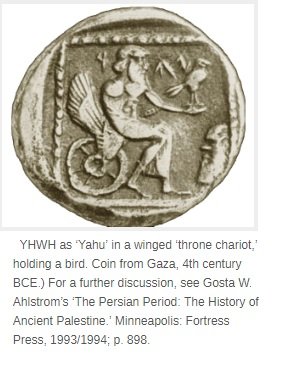𝐇𝐨𝐰 𝐭𝐡𝐞 𝐉𝐞𝐰𝐬 𝐈𝐧𝐯𝐞𝐧𝐭𝐞𝐝 𝐘𝐚𝐡𝐰𝐞𝐡, 𝐚𝐧𝐝 𝐌𝐚𝐝𝐞 𝐇𝐢𝐦 𝐆𝐫𝐞𝐚𝐭
Mohamad Mostafa Nassar
Twitter:@NassarMohamadMR

𝐓𝐡𝐞 𝐆𝐨𝐝 𝐨𝐟 𝐭𝐡𝐞 𝐎𝐥𝐝 𝐓𝐞𝐬𝐭𝐚𝐦𝐞𝐧𝐭 𝐬𝐭𝐚𝐫𝐭𝐞𝐝 𝐨𝐮𝐭 𝐚𝐬 𝐣𝐮𝐬𝐭 𝐨𝐧𝐞 𝐨𝐟 𝐦𝐚𝐧𝐲 𝐝𝐞𝐢𝐭𝐢𝐞𝐬 𝐨𝐟 𝐭𝐡𝐞 𝐚𝐧𝐜𝐢𝐞𝐧𝐭 𝐈𝐬𝐫𝐚𝐞𝐥𝐢𝐭𝐞𝐬. 𝐈𝐭 𝐭𝐨𝐨𝐤 𝐚 𝐭𝐫𝐚𝐮𝐦𝐚𝐭𝐢𝐜 𝐜𝐫𝐢𝐬𝐢𝐬 𝐭𝐨 𝐦𝐚𝐤𝐞 𝐡𝐢𝐦 𝐢𝐧𝐭𝐨 𝐭𝐡𝐞 𝐚𝐥𝐥-𝐩𝐨𝐰𝐞𝐫𝐟𝐮𝐥 𝐜𝐫𝐞𝐚𝐭𝐨𝐫 𝐨𝐟 𝐭𝐡𝐞 𝐰𝐨𝐫𝐥𝐝.
𝐉𝐞𝐰𝐬, 𝐂𝐡𝐫𝐢𝐬𝐭𝐢𝐚𝐧𝐬, 𝐚𝐧𝐝 𝐌𝐮𝐬𝐥𝐢𝐦𝐬 𝐚𝐥𝐥 𝐛𝐞𝐥𝐢𝐞𝐯𝐞 𝐢𝐧 𝐚 𝐬𝐢𝐧𝐠𝐥𝐞, 𝐨𝐦𝐧𝐢𝐩𝐨𝐭𝐞𝐧𝐭 𝐝𝐞𝐢𝐭𝐲 𝐭𝐡𝐚𝐭 𝐜𝐫𝐞𝐚𝐭𝐞𝐝 𝐭𝐡𝐞 𝐡𝐞𝐚𝐯𝐞𝐧𝐬 𝐚𝐧𝐝 𝐞𝐚𝐫𝐭𝐡. 𝐁𝐮𝐭 𝐢𝐟 𝐡𝐞 𝐰𝐚𝐬 𝐚𝐧𝐝 𝐢𝐬 𝐭𝐡𝐞 𝐨𝐧𝐥𝐲 𝐠𝐨𝐝, 𝐰𝐡𝐚𝐭 𝐢𝐬 𝐡𝐢𝐬 𝐧𝐚𝐦𝐞?
𝐓𝐡𝐞 𝐁𝐢𝐛𝐥𝐞 𝐞𝐱𝐩𝐥𝐢𝐜𝐢𝐭𝐥𝐲 𝐭𝐞𝐥𝐥𝐬 𝐮𝐬 𝐭𝐡𝐚𝐭 𝐆𝐨𝐝 𝐡𝐚𝐬 𝐨𝐧𝐞, 𝐰𝐡𝐢𝐜𝐡 𝐢𝐧𝐝𝐢𝐜𝐚𝐭𝐞𝐬 𝐡𝐞 𝐡𝐚𝐝 𝐭𝐨 𝐛𝐞 𝐝𝐢𝐬𝐭𝐢𝐧𝐠𝐮𝐢𝐬𝐡𝐞𝐝 𝐟𝐫𝐨𝐦 𝐨𝐭𝐡𝐞𝐫 𝐜𝐞𝐥𝐞𝐬𝐭𝐢𝐚𝐥 𝐛𝐞𝐢𝐧𝐠𝐬, 𝐣𝐮𝐬𝐭 𝐥𝐢𝐤𝐞 𝐡𝐮𝐦𝐚𝐧𝐬 𝐮𝐬𝐞 𝐧𝐚𝐦𝐞𝐬 𝐭𝐨 𝐢𝐝𝐞𝐧𝐭𝐢𝐟𝐲 𝐝𝐢𝐟𝐟𝐞𝐫𝐞𝐧𝐭 𝐩𝐞𝐨𝐩𝐥𝐞.
𝐖𝐡𝐚𝐭 𝐭𝐡𝐚𝐭 𝐧𝐚𝐦𝐞 𝐦𝐢𝐠𝐡𝐭 𝐛𝐞 𝐢𝐬 𝐚𝐧𝐨𝐭𝐡𝐞𝐫 𝐦𝐚𝐭𝐭𝐞𝐫. 𝐓𝐡𝐞 𝐉𝐞𝐰𝐢𝐬𝐡 𝐩𝐫𝐨𝐡𝐢𝐛𝐢𝐭𝐢𝐨𝐧 𝐨𝐧 𝐬𝐩𝐞𝐚𝐤𝐢𝐧𝐠 𝐆𝐨𝐝’𝐬 𝐧𝐚𝐦𝐞 𝐦𝐞𝐚𝐧𝐬 𝐭𝐡𝐚𝐭 𝐢𝐭𝐬 𝐜𝐨𝐫𝐫𝐞𝐜𝐭 𝐩𝐫𝐨𝐧𝐮𝐧𝐜𝐢𝐚𝐭𝐢𝐨𝐧 𝐡𝐚𝐬 𝐛𝐞𝐞𝐧 𝐥𝐨𝐬𝐭. 𝐀𝐥𝐥 𝐰𝐞 𝐤𝐧𝐨𝐰 𝐢𝐬 𝐭𝐡𝐚𝐭 𝐭𝐡𝐞 𝐇𝐞𝐛𝐫𝐞𝐰 𝐁𝐢𝐛𝐥𝐞 𝐬𝐩𝐞𝐥𝐥𝐬 𝐢𝐭 𝐨𝐮𝐭 𝐚𝐬 𝐟𝐨𝐮𝐫 𝐜𝐨𝐧𝐬𝐨𝐧𝐚𝐧𝐭𝐬 𝐤𝐧𝐨𝐰𝐧 𝐚𝐬 𝐭𝐡𝐞 𝐓𝐞𝐭𝐫𝐚𝐠𝐫𝐚𝐦𝐦𝐚𝐭𝐨𝐧 – 𝐟𝐫𝐨𝐦 𝐭𝐡𝐞 𝐆𝐫𝐞𝐞𝐤 𝐟𝐨𝐫 “𝐟𝐨𝐮𝐫 𝐥𝐞𝐭𝐭𝐞𝐫𝐬,” 𝐰𝐡𝐢𝐜𝐡 𝐚𝐫𝐞 𝐭𝐫𝐚𝐧𝐬𝐥𝐢𝐭𝐞𝐫𝐚𝐭𝐞𝐝 𝐚𝐬 𝐘-𝐇-𝐖-𝐇.
𝐓𝐡𝐞 𝐞𝐱𝐢𝐬𝐭𝐞𝐧𝐜𝐞 𝐨𝐟 𝐚 𝐩𝐫𝐨𝐩𝐞𝐫 𝐧𝐚𝐦𝐞 𝐟𝐨𝐫 𝐆𝐨𝐝 𝐢𝐬 𝐭𝐡𝐞 𝐟𝐢𝐫𝐬𝐭 𝐢𝐧𝐝𝐢𝐜𝐚𝐭𝐢𝐨𝐧 𝐭𝐡𝐚𝐭 𝐭𝐡𝐞 𝐡𝐢𝐬𝐭𝐨𝐫𝐲 𝐨𝐟 𝐘𝐡𝐰𝐡 𝐚𝐧𝐝 𝐡𝐢𝐬 𝐰𝐨𝐫𝐬𝐡𝐢𝐩 𝐛𝐲 𝐭𝐡𝐞 𝐉𝐞𝐰𝐬 𝐢𝐬 𝐚 𝐥𝐨𝐭 𝐦𝐨𝐫𝐞 𝐜𝐨𝐦𝐩𝐥𝐢𝐜𝐚𝐭𝐞𝐝 𝐭𝐡𝐚𝐧 𝐦𝐚𝐧𝐲 𝐫𝐞𝐚𝐥𝐢𝐳𝐞.

𝐈𝐧 𝐆𝐨𝐝𝐬 𝐰𝐞 𝐭𝐫𝐮𝐬𝐭𝐞𝐝?
𝐌𝐨𝐝𝐞𝐫𝐧 𝐛𝐢𝐛𝐥𝐢𝐜𝐚𝐥 𝐬𝐜𝐡𝐨𝐥𝐚𝐫𝐬𝐡𝐢𝐩 𝐚𝐧𝐝 𝐚𝐫𝐜𝐡𝐚𝐞𝐨𝐥𝐨𝐠𝐢𝐜𝐚𝐥 𝐝𝐢𝐬𝐜𝐨𝐯𝐞𝐫𝐢𝐞𝐬 𝐢𝐧 𝐚𝐧𝐝 𝐚𝐫𝐨𝐮𝐧𝐝 𝐈𝐬𝐫𝐚𝐞𝐥 𝐬𝐡𝐨𝐰 𝐭𝐡𝐚𝐭 𝐭𝐡𝐞 𝐚𝐧𝐜𝐢𝐞𝐧𝐭 𝐈𝐬𝐫𝐚𝐞𝐥𝐢𝐭𝐞𝐬 𝐝𝐢𝐝 𝐧𝐨𝐭 𝐚𝐥𝐰𝐚𝐲𝐬 𝐛𝐞𝐥𝐢𝐞𝐯𝐞 𝐢𝐧 𝐚 𝐬𝐢𝐧𝐠𝐥𝐞, 𝐮𝐧𝐢𝐯𝐞𝐫𝐬𝐚𝐥 𝐠𝐨𝐝. 𝐈𝐧 𝐟𝐚𝐜𝐭, 𝐦𝐨𝐧𝐨𝐭𝐡𝐞𝐢𝐬𝐦 𝐢𝐬 𝐚 𝐫𝐞𝐥𝐚𝐭𝐢𝐯𝐞𝐥𝐲 𝐫𝐞𝐜𝐞𝐧𝐭 𝐜𝐨𝐧𝐜𝐞𝐩𝐭, 𝐞𝐯𝐞𝐧 𝐚𝐦𝐨𝐧𝐠𝐬𝐭 𝐭𝐡𝐞 𝐏𝐞𝐨𝐩𝐥𝐞 𝐨𝐟 𝐭𝐡𝐞 𝐁𝐨𝐨𝐤.
𝐃𝐞𝐜𝐚𝐝𝐞𝐬 𝐨𝐟 𝐫𝐞𝐬𝐞𝐚𝐫𝐜𝐡 𝐢𝐧𝐭𝐨 𝐭𝐡𝐞 𝐛𝐢𝐫𝐭𝐡 𝐚𝐧𝐝 𝐞𝐯𝐨𝐥𝐮𝐭𝐢𝐨𝐧 𝐨𝐟 𝐭𝐡𝐞 𝐘𝐡𝐰𝐡 𝐜𝐮𝐥𝐭 𝐚𝐫𝐞 𝐬𝐮𝐦𝐦𝐚𝐫𝐢𝐳𝐞𝐝 𝐢𝐧 “𝐓𝐡𝐞 𝐈𝐧𝐯𝐞𝐧𝐭𝐢𝐨𝐧 𝐨𝐟 𝐆𝐨𝐝,” 𝐚 𝐫𝐞𝐜𝐞𝐧𝐭 𝐛𝐨𝐨𝐤 𝐛𝐲 𝐓𝐡𝐨𝐦𝐚𝐬 𝐑𝐨̈𝐦𝐞𝐫, 𝐚 𝐰𝐨𝐫𝐥𝐝-𝐫𝐞𝐧𝐨𝐰𝐧𝐞𝐝 𝐞𝐱𝐩𝐞𝐫𝐭 𝐢𝐧 𝐭𝐡𝐞 𝐇𝐞𝐛𝐫𝐞𝐰 𝐁𝐢𝐛𝐥𝐞 𝐚𝐧𝐝 𝐩𝐫𝐨𝐟𝐞𝐬𝐬𝐨𝐫 𝐚𝐭 𝐭𝐡𝐞 𝐂𝐨𝐥𝐥𝐞𝐠𝐞 𝐝𝐞 𝐅𝐫𝐚𝐧𝐜𝐞 𝐚𝐧𝐝 𝐭𝐡𝐞 𝐔𝐧𝐢𝐯𝐞𝐫𝐬𝐢𝐭𝐲 𝐨𝐟 𝐋𝐚𝐮𝐬𝐚𝐧𝐧𝐞. 𝐑𝐨̈𝐦𝐞𝐫, 𝐰𝐡𝐨 𝐡𝐞𝐥𝐝 𝐚 𝐬𝐞𝐫𝐢𝐞𝐬 𝐨𝐟 𝐜𝐨𝐧𝐟𝐞𝐫𝐞𝐧𝐜𝐞𝐬 𝐚𝐭 𝐓𝐞𝐥 𝐀𝐯𝐢𝐯 𝐔𝐧𝐢𝐯𝐞𝐫𝐬𝐢𝐭𝐲 𝐥𝐚𝐬𝐭 𝐦𝐨𝐧𝐭𝐡, 𝐬𝐩𝐨𝐤𝐞 𝐭𝐨 𝐇𝐚𝐚𝐫𝐞𝐭𝐳 𝐚𝐛𝐨𝐮𝐭 𝐭𝐡𝐞 𝐬𝐮𝐛𝐣𝐞𝐜𝐭.
𝐓𝐡𝐞 𝐦𝐚𝐢𝐧 𝐬𝐨𝐮𝐫𝐜𝐞 𝐟𝐨𝐫 𝐢𝐧𝐯𝐞𝐬𝐭𝐢𝐠𝐚𝐭𝐢𝐧𝐠 𝐭𝐡𝐞 𝐡𝐢𝐬𝐭𝐨𝐫𝐲 𝐨𝐟 𝐆𝐨𝐝 𝐢𝐬, 𝐨𝐟 𝐜𝐨𝐮𝐫𝐬𝐞, 𝐭𝐡𝐞 𝐁𝐢𝐛𝐥𝐞 𝐢𝐭𝐬𝐞𝐥𝐟.
𝐖𝐡𝐞𝐧 𝐞𝐱𝐚𝐜𝐭𝐥𝐲 𝐭𝐡𝐞 𝐉𝐞𝐰𝐢𝐬𝐡 𝐡𝐨𝐥𝐲 𝐭𝐞𝐱𝐭 𝐫𝐞𝐚𝐜𝐡𝐞𝐝 𝐢𝐭𝐬 𝐟𝐢𝐧𝐚𝐥 𝐟𝐨𝐫𝐦 𝐢𝐬 𝐮𝐧𝐤𝐧𝐨𝐰𝐧. 𝐌𝐚𝐧𝐲 𝐬𝐜𝐡𝐨𝐥𝐚𝐫𝐬 𝐛𝐞𝐥𝐢𝐞𝐯𝐞 𝐭𝐡𝐢𝐬 𝐡𝐚𝐩𝐩𝐞𝐧𝐞𝐝 𝐬𝐨𝐦𝐞𝐭𝐢𝐦𝐞 𝐛𝐞𝐭𝐰𝐞𝐞𝐧 𝐭𝐡𝐞 𝐁𝐚𝐛𝐲𝐥𝐨𝐧𝐢𝐚𝐧 𝐞𝐱𝐢𝐥𝐞, 𝐰𝐡𝐢𝐜𝐡 𝐛𝐞𝐠𝐚𝐧 𝐚𝐟𝐭𝐞𝐫 𝐭𝐡𝐞 𝐟𝐚𝐥𝐥 𝐨𝐟 𝐉𝐞𝐫𝐮𝐬𝐚𝐥𝐞𝐦 𝐢𝐧 𝟓𝟖𝟕 𝐁𝐂𝐄 (𝐬𝐨𝐦𝐞 𝟐𝟔𝟎𝟎 𝐲𝐞𝐚𝐫𝐬 𝐚𝐠𝐨), 𝐚𝐧𝐝 𝐭𝐡𝐞 𝐬𝐮𝐛𝐬𝐞𝐪𝐮𝐞𝐧𝐭 𝐩𝐞𝐫𝐢𝐨𝐝𝐬 𝐨𝐟 𝐏𝐞𝐫𝐬𝐢𝐚𝐧 𝐚𝐧𝐝 𝐇𝐞𝐥𝐥𝐞𝐧𝐢𝐬𝐭𝐢𝐜 𝐫𝐮𝐥𝐞.
𝐇𝐨𝐰𝐞𝐯𝐞𝐫, 𝐭𝐡𝐞 𝐫𝐞𝐝𝐚𝐜𝐭𝐨𝐫𝐬 𝐨𝐟 𝐭𝐡𝐞 𝐁𝐢𝐛𝐥𝐞 𝐰𝐞𝐫𝐞 𝐞𝐯𝐢𝐝𝐞𝐧𝐭𝐥𝐲 𝐰𝐨𝐫𝐤𝐢𝐧𝐠 𝐨𝐟𝐟 𝐨𝐥𝐝𝐞𝐫 𝐭𝐫𝐚𝐝𝐢𝐭𝐢𝐨𝐧𝐬, 𝐑𝐨̈𝐦𝐞𝐫 𝐬𝐚𝐲𝐬.
𝐓𝐨𝐩 𝐨𝐟 𝐅𝐨𝐫𝐦
“𝐁𝐢𝐛𝐥𝐢𝐜𝐚𝐥 𝐭𝐞𝐱𝐭𝐬 𝐚𝐫𝐞 𝐧𝐨𝐭 𝐝𝐢𝐫𝐞𝐜𝐭 𝐡𝐢𝐬𝐭𝐨𝐫𝐢𝐜𝐚𝐥 𝐬𝐨𝐮𝐫𝐜𝐞𝐬. 𝐓𝐡𝐞𝐲 𝐫𝐞𝐟𝐥𝐞𝐜𝐭 𝐭𝐡𝐞 𝐢𝐝𝐞𝐚𝐬, 𝐭𝐡𝐞 𝐢𝐝𝐞𝐨𝐥𝐨𝐠𝐢𝐞𝐬 𝐨𝐟 𝐭𝐡𝐞𝐢𝐫 𝐚𝐮𝐭𝐡𝐨𝐫𝐬 𝐚𝐧𝐝 𝐨𝐟 𝐜𝐨𝐮𝐫𝐬𝐞 𝐨𝐟 𝐭𝐡𝐞 𝐡𝐢𝐬𝐭𝐨𝐫𝐢𝐜𝐚𝐥 𝐜𝐨𝐧𝐭𝐞𝐱𝐭 𝐢𝐧 𝐰𝐡𝐢𝐜𝐡 𝐭𝐡𝐞𝐲 𝐰𝐞𝐫𝐞 𝐰𝐫𝐢𝐭𝐭𝐞𝐧,” 𝐑𝐨̈𝐦𝐞𝐫 𝐞𝐱𝐩𝐥𝐚𝐢𝐧𝐬.
𝐒𝐭𝐢𝐥𝐥, 𝐡𝐞 𝐧𝐨𝐭𝐞𝐬, “𝐘𝐨𝐮 𝐜𝐚𝐧 𝐡𝐚𝐯𝐞 𝐦𝐞𝐦𝐨𝐫𝐢𝐞𝐬 𝐨𝐟 𝐚 𝐝𝐢𝐬𝐭𝐚𝐧𝐭 𝐩𝐚𝐬𝐭, 𝐬𝐨𝐦𝐞𝐭𝐢𝐦𝐞𝐬 𝐢𝐧 𝐚 𝐯𝐞𝐫𝐲 𝐜𝐨𝐧𝐟𝐮𝐬𝐢𝐧𝐠 𝐰𝐚𝐲 𝐨𝐫 𝐢𝐧 𝐚 𝐯𝐞𝐫𝐲 𝐨𝐫𝐢𝐞𝐧𝐭𝐞𝐝 𝐰𝐚𝐲. 𝐁𝐮𝐭 𝐈 𝐭𝐡𝐢𝐧𝐤 𝐰𝐞 𝐜𝐚𝐧, 𝐚𝐧𝐝 𝐰𝐞 𝐦𝐮𝐬𝐭 𝐮𝐬𝐞 𝐭𝐡𝐞 𝐛𝐢𝐛𝐥𝐢𝐜𝐚𝐥 𝐭𝐞𝐱𝐭 𝐧𝐨𝐭 𝐣𝐮𝐬𝐭 𝐚𝐬 𝐟𝐢𝐜𝐭𝐢𝐨𝐧𝐚𝐥 𝐭𝐞𝐱𝐭𝐬 𝐛𝐮𝐭 𝐚𝐬 𝐭𝐞𝐱𝐭𝐬 𝐭𝐡𝐚𝐭 𝐜𝐚𝐧 𝐭𝐞𝐥𝐥 𝐮𝐬 𝐬𝐭𝐨𝐫𝐢𝐞𝐬 𝐚𝐛𝐨𝐮𝐭 𝐭𝐡𝐞 𝐨𝐫𝐢𝐠𝐢𝐧𝐬.”
𝐖𝐡𝐚𝐭 𝐢𝐬 𝐢𝐧 𝐆𝐨𝐝’𝐬 𝐧𝐚𝐦𝐞
𝐓𝐡𝐞 𝐟𝐢𝐫𝐬𝐭 𝐜𝐥𝐮𝐞 𝐭𝐡𝐚𝐭 𝐭𝐡𝐞 𝐚𝐧𝐜𝐢𝐞𝐧𝐭 𝐈𝐬𝐫𝐚𝐞𝐥𝐢𝐭𝐞𝐬 𝐰𝐨𝐫𝐬𝐡𝐢𝐩𝐩𝐞𝐝 𝐠𝐨𝐝𝐬 𝐨𝐭𝐡𝐞𝐫 𝐭𝐡𝐚𝐧 𝐭𝐡𝐞 𝐝𝐞𝐢𝐭𝐲 𝐤𝐧𝐨𝐰𝐧 𝐚𝐬 𝐘𝐡𝐰𝐡 𝐥𝐢𝐞𝐬 𝐢𝐧 𝐭𝐡𝐞𝐢𝐫 𝐯𝐞𝐫𝐲 𝐧𝐚𝐦𝐞. “𝐈𝐬𝐫𝐚𝐞𝐥” 𝐢𝐬 𝐚 𝐭𝐡𝐞𝐨𝐩𝐡𝐨𝐫𝐢𝐜 𝐧𝐚𝐦𝐞 𝐠𝐨𝐢𝐧𝐠 𝐛𝐚𝐜𝐤 𝐚𝐭 𝐥𝐞𝐚𝐬𝐭 𝟑𝟐𝟎𝟎 𝐲𝐞𝐚𝐫𝐬, 𝐰𝐡𝐢𝐜𝐡 𝐢𝐧𝐜𝐥𝐮𝐝𝐞𝐬 𝐚𝐧𝐝 𝐢𝐧𝐯𝐨𝐤𝐞𝐬 𝐭𝐡𝐞 𝐧𝐚𝐦𝐞 𝐨𝐟 𝐚 𝐩𝐫𝐨𝐭𝐞𝐜𝐭𝐢𝐯𝐞 𝐝𝐞𝐢𝐭𝐲.
𝐆𝐨𝐢𝐧𝐠 𝐛𝐲 𝐭𝐡𝐞 𝐧𝐚𝐦𝐞, 𝐭𝐡𝐞 𝐦𝐚𝐢𝐧 𝐠𝐨𝐝 𝐨𝐟 𝐭𝐡𝐞 𝐚𝐧𝐜𝐢𝐞𝐧𝐭 𝐈𝐬𝐫𝐚𝐞𝐥𝐢𝐭𝐞𝐬 𝐰𝐚𝐬 𝐧𝐨𝐭 𝐘𝐡𝐰𝐡, 𝐛𝐮𝐭 𝐄𝐥, 𝐭𝐡𝐞 𝐜𝐡𝐢𝐞𝐟 𝐝𝐞𝐢𝐭𝐲 𝐢𝐧 𝐭𝐡𝐞 𝐂𝐚𝐧𝐚𝐚𝐧𝐢𝐭𝐞 𝐩𝐚𝐧𝐭𝐡𝐞𝐨𝐧, 𝐰𝐡𝐨 𝐰𝐚𝐬 𝐰𝐨𝐫𝐬𝐡𝐢𝐩𝐩𝐞𝐝 𝐭𝐡𝐫𝐨𝐮𝐠𝐡𝐨𝐮𝐭 𝐭𝐡𝐞 𝐋𝐞𝐯𝐚𝐧𝐭.
𝐈𝐧 𝐨𝐭𝐡𝐞𝐫 𝐰𝐨𝐫𝐝𝐬, 𝐭𝐡𝐞 𝐧𝐚𝐦𝐞 “𝐈𝐬𝐫𝐚𝐞𝐥” 𝐢𝐬 𝐩𝐫𝐨𝐛𝐚𝐛𝐥𝐲 𝐨𝐥𝐝𝐞𝐫 𝐭𝐡𝐚𝐧 𝐭𝐡𝐞 𝐯𝐞𝐧𝐞𝐫𝐚𝐭𝐢𝐨𝐧 𝐨𝐟 𝐘𝐡𝐰𝐡 𝐛𝐲 𝐭𝐡𝐢𝐬 𝐠𝐫𝐨𝐮𝐩 𝐜𝐚𝐥𝐥𝐞𝐝 𝐈𝐬𝐫𝐚𝐞𝐥, 𝐑𝐨̈𝐦𝐞𝐫 𝐬𝐚𝐲𝐬. “𝐓𝐡𝐞 𝐟𝐢𝐫𝐬𝐭 𝐭𝐮𝐭𝐞𝐥𝐚𝐫𝐲 𝐝𝐞𝐢𝐭𝐲 𝐭𝐡𝐞𝐲 𝐰𝐞𝐫𝐞 𝐰𝐨𝐫𝐬𝐡𝐢𝐩𝐩𝐢𝐧𝐠 𝐰𝐚𝐬 𝐄𝐥, 𝐨𝐭𝐡𝐞𝐫𝐰𝐢𝐬𝐞 𝐭𝐡𝐞𝐢𝐫 𝐧𝐚𝐦𝐞 𝐰𝐨𝐮𝐥𝐝 𝐡𝐚𝐯𝐞 𝐛𝐞𝐞𝐧 𝐈𝐬𝐫𝐚𝐲𝐚𝐡𝐮.”
𝐓𝐡𝐞 𝐁𝐢𝐛𝐥𝐞 𝐚𝐩𝐩𝐞𝐚𝐫𝐬 𝐭𝐨 𝐚𝐝𝐝𝐫𝐞𝐬𝐬 𝐭𝐡𝐢𝐬 𝐞𝐚𝐫𝐥𝐲 𝐰𝐨𝐫𝐬𝐡𝐢𝐩 𝐨𝐟 𝐄𝐥 𝐢𝐧 𝐄𝐱𝐨𝐝𝐮𝐬 𝟔:𝟑, 𝐰𝐡𝐞𝐧 𝐆𝐨𝐝 𝐭𝐞𝐥𝐥𝐬 𝐌𝐨𝐬𝐞𝐬 𝐭𝐡𝐚𝐭 𝐡𝐞 “𝐚𝐩𝐩𝐞𝐚𝐫𝐞𝐝 𝐭𝐨 𝐀𝐛𝐫𝐚𝐡𝐚𝐦, 𝐈𝐬𝐚𝐚𝐜 𝐚𝐧𝐝 𝐉𝐚𝐜𝐨𝐛 𝐚𝐬 𝐄𝐥 𝐒𝐡𝐚𝐝𝐝𝐚𝐢 (𝐭𝐨𝐝𝐚𝐲 𝐭𝐫𝐚𝐧𝐬𝐥𝐚𝐭𝐞𝐝 𝐚𝐬 “𝐆𝐨𝐝 𝐀𝐥𝐦𝐢𝐠𝐡𝐭𝐲”) 𝐛𝐮𝐭 𝐰𝐚𝐬 𝐧𝐨𝐭 𝐤𝐧𝐨𝐰𝐧 𝐭𝐨 𝐭𝐡𝐞𝐦 𝐛𝐲 𝐦𝐲 𝐧𝐚𝐦𝐞 𝐘𝐡𝐰𝐡.”
𝐈𝐧 𝐟𝐚𝐜𝐭, 𝐢𝐭 𝐬𝐞𝐞𝐦𝐬 𝐭𝐡𝐚𝐭 𝐭𝐡𝐞 𝐚𝐧𝐜𝐢𝐞𝐧𝐭 𝐈𝐬𝐫𝐚𝐞𝐥𝐢𝐭𝐞𝐬 𝐰𝐞𝐫𝐞𝐧’𝐭 𝐞𝐯𝐞𝐧 𝐭𝐡𝐞 𝐟𝐢𝐫𝐬𝐭 𝐭𝐨 𝐰𝐨𝐫𝐬𝐡𝐢𝐩 𝐘𝐡𝐰𝐡 – 𝐭𝐡𝐞𝐲 𝐬𝐞𝐞𝐦 𝐭𝐨 𝐡𝐚𝐯𝐞 𝐚𝐝𝐨𝐩𝐭𝐞𝐝 𝐇𝐢𝐦 𝐟𝐫𝐨𝐦 𝐚 𝐦𝐲𝐬𝐭𝐞𝐫𝐢𝐨𝐮𝐬, 𝐮𝐧𝐤𝐧𝐨𝐰𝐧 𝐭𝐫𝐢𝐛𝐞 𝐭𝐡𝐚𝐭 𝐥𝐢𝐯𝐞𝐝 𝐬𝐨𝐦𝐞𝐰𝐡𝐞𝐫𝐞 𝐢𝐧 𝐭𝐡𝐞 𝐝𝐞𝐬𝐞𝐫𝐭𝐬 𝐨𝐟 𝐭𝐡𝐞 𝐬𝐨𝐮𝐭𝐡𝐞𝐫𝐧 𝐋𝐞𝐯𝐚𝐧𝐭 𝐚𝐧𝐝 𝐀𝐫𝐚𝐛𝐢𝐚.
𝐓𝐡𝐞 𝐠𝐨𝐝 𝐨𝐟 𝐭𝐡𝐞 𝐬𝐨𝐮𝐭𝐡𝐞𝐫𝐧 𝐝𝐞𝐬𝐞𝐫𝐭𝐬
𝐓𝐡𝐞 𝐟𝐢𝐫𝐬𝐭 𝐦𝐞𝐧𝐭𝐢𝐨𝐧 𝐨𝐟 𝐭𝐡𝐞 𝐈𝐬𝐫𝐚𝐞𝐥𝐢𝐭𝐞 𝐭𝐫𝐢𝐛𝐞 𝐢𝐭𝐬𝐞𝐥𝐟 𝐢𝐬 𝐚 𝐯𝐢𝐜𝐭𝐨𝐫𝐲 𝐬𝐭𝐞𝐥𝐞 𝐞𝐫𝐞𝐜𝐭𝐞𝐝 𝐚𝐫𝐨𝐮𝐧𝐝 𝟏𝟐𝟏𝟎 𝐁𝐂𝐄 𝐛𝐲 𝐭𝐡𝐞 𝐩𝐡𝐚𝐫𝐚𝐨𝐡 𝐌𝐞𝐫𝐧𝐞𝐭𝐩𝐚𝐡 (𝐬𝐨𝐦𝐞𝐭𝐢𝐦𝐞𝐬 𝐜𝐚𝐥𝐥𝐞𝐝 “𝐭𝐡𝐞 𝐈𝐬𝐫𝐚𝐞𝐥 𝐬𝐭𝐞𝐥𝐞”). 𝐓𝐡𝐞𝐬𝐞 𝐈𝐬𝐫𝐚𝐞𝐥𝐢𝐭𝐞𝐬 𝐚𝐫𝐞 𝐝𝐞𝐬𝐜𝐫𝐢𝐛𝐞𝐝 𝐚𝐬 𝐚 𝐩𝐞𝐨𝐩𝐥𝐞 𝐢𝐧𝐡𝐚𝐛𝐢𝐭𝐢𝐧𝐠 𝐂𝐚𝐧𝐚𝐚𝐧.
𝐒𝐨 𝐡𝐨𝐰 𝐝𝐢𝐝 𝐭𝐡𝐢𝐬 𝐠𝐫𝐨𝐮𝐩 𝐨𝐟 𝐂𝐚𝐧𝐚𝐚𝐧𝐢𝐭𝐞 𝐄𝐥-𝐰𝐨𝐫𝐬𝐡𝐢𝐩𝐩𝐞𝐫𝐬 𝐜𝐨𝐦𝐞 𝐢𝐧 𝐜𝐨𝐧𝐭𝐚𝐜𝐭 𝐰𝐢𝐭𝐡 𝐭𝐡𝐞 𝐜𝐮𝐥𝐭 𝐨𝐟 𝐘𝐡𝐰𝐡?
𝐓𝐡𝐞 𝐁𝐢𝐛𝐥𝐞 𝐢𝐬 𝐪𝐮𝐢𝐭𝐞 𝐞𝐱𝐩𝐥𝐢𝐜𝐢𝐭 𝐚𝐛𝐨𝐮𝐭 𝐭𝐡𝐞 𝐠𝐞𝐨𝐠𝐫𝐚𝐩𝐡𝐢𝐜𝐚𝐥 𝐫𝐨𝐨𝐭𝐬 𝐨𝐟 𝐭𝐡𝐞 𝐘𝐡𝐰𝐡 𝐝𝐞𝐢𝐭𝐲, 𝐫𝐞𝐩𝐞𝐚𝐭𝐞𝐝𝐥𝐲 𝐥𝐢𝐧𝐤𝐢𝐧𝐠 𝐡𝐢𝐬 𝐩𝐫𝐞𝐬𝐞𝐧𝐜𝐞 𝐭𝐨 𝐭𝐡𝐞 𝐦𝐨𝐮𝐧𝐭𝐚𝐢𝐧𝐨𝐮𝐬 𝐰𝐢𝐥𝐝𝐞𝐫𝐧𝐞𝐬𝐬 𝐚𝐧𝐝 𝐭𝐡𝐞 𝐝𝐞𝐬𝐞𝐫𝐭𝐬 𝐨𝐟 𝐭𝐡𝐞 𝐬𝐨𝐮𝐭𝐡𝐞𝐫𝐧 𝐋𝐞𝐯𝐚𝐧𝐭. 𝐉𝐮𝐝𝐠𝐞𝐬 𝟓:𝟒 𝐬𝐚𝐲𝐬 𝐭𝐡𝐚𝐭 𝐘𝐡𝐰𝐡 “𝐰𝐞𝐧𝐭 𝐟𝐨𝐫𝐭𝐡 𝐟𝐫𝐨𝐦 𝐒𝐞𝐢𝐫” 𝐚𝐧𝐝 “𝐦𝐚𝐫𝐜𝐡𝐞𝐝 𝐨𝐮𝐭 𝐨𝐟 𝐭𝐡𝐞 𝐟𝐢𝐞𝐥𝐝 𝐨𝐟 𝐄𝐝𝐨𝐦.” 𝐇𝐚𝐛𝐛𝐚𝐤𝐮𝐤 𝟑:𝟑 𝐭𝐞𝐥𝐥𝐬 𝐮𝐬 𝐭𝐡𝐚𝐭 “𝐆𝐨𝐝 𝐜𝐚𝐦𝐞 𝐟𝐫𝐨𝐦 𝐓𝐞𝐦𝐚𝐧,” 𝐬𝐩𝐞𝐜𝐢𝐟𝐢𝐜𝐚𝐥𝐥𝐲 𝐟𝐫𝐨𝐦 𝐌𝐨𝐮𝐧𝐭 𝐏𝐚𝐫𝐚𝐧.
𝐀𝐥𝐥 𝐭𝐡𝐞𝐬𝐞 𝐫𝐞𝐠𝐢𝐨𝐧𝐬 𝐚𝐧𝐝 𝐥𝐨𝐜𝐚𝐭𝐢𝐨𝐧𝐬 𝐜𝐚𝐧 𝐛𝐞 𝐢𝐝𝐞𝐧𝐭𝐢𝐟𝐢𝐞𝐝 𝐰𝐢𝐭𝐡 𝐭𝐡𝐞 𝐭𝐞𝐫𝐫𝐢𝐭𝐨𝐫𝐲 𝐭𝐡𝐚𝐭 𝐫𝐚𝐧𝐠𝐞𝐬 𝐟𝐫𝐨𝐦 𝐭𝐡𝐞 𝐒𝐢𝐧𝐚𝐢 𝐚𝐧𝐝 𝐍𝐞𝐠𝐞𝐯 𝐭𝐨 𝐧𝐨𝐫𝐭𝐡𝐞𝐫𝐧 𝐀𝐫𝐚𝐛𝐢𝐚.
𝐘𝐡𝐰𝐡’𝐬 𝐩𝐞𝐧𝐜𝐡𝐚𝐧𝐭 𝐟𝐨𝐫 𝐚𝐩𝐩𝐞𝐚𝐫𝐢𝐧𝐠 𝐢𝐧 𝐭𝐡𝐞 𝐛𝐢𝐛𝐥𝐢𝐜𝐚𝐥 𝐧𝐚𝐫𝐫𝐚𝐭𝐢𝐯𝐞 𝐨𝐧 𝐭𝐨𝐩 𝐨𝐟 𝐦𝐨𝐮𝐧𝐭𝐚𝐢𝐧𝐬 𝐚𝐧𝐝 𝐚𝐜𝐜𝐨𝐦𝐩𝐚𝐧𝐢𝐞𝐝 𝐛𝐲 𝐝𝐚𝐫𝐤 𝐜𝐥𝐨𝐮𝐝𝐬 𝐚𝐧𝐝 𝐭𝐡𝐮𝐧𝐝𝐞𝐫 𝐚𝐫𝐞 𝐚𝐥𝐬𝐨 𝐭𝐲𝐩𝐢𝐜𝐚𝐥 𝐚𝐭𝐭𝐫𝐢𝐛𝐮𝐭𝐞𝐬 𝐨𝐟 𝐚 𝐝𝐞𝐢𝐭𝐲 𝐨𝐫𝐢𝐠𝐢𝐧𝐚𝐭𝐢𝐧𝐠 𝐢𝐧 𝐭𝐡𝐞 𝐰𝐢𝐥𝐝𝐞𝐫𝐧𝐞𝐬𝐬, 𝐩𝐨𝐬𝐬𝐢𝐛𝐥𝐲 𝐚 𝐠𝐨𝐝 𝐨𝐟 𝐬𝐭𝐨𝐫𝐦𝐬 𝐚𝐧𝐝 𝐟𝐞𝐫𝐭𝐢𝐥𝐢𝐭𝐲.
𝐒𝐮𝐩𝐩𝐨𝐫𝐭 𝐟𝐨𝐫 𝐭𝐡𝐞 𝐭𝐡𝐞𝐨𝐫𝐲 𝐭𝐡𝐚𝐭 𝐘𝐡𝐰𝐡 𝐨𝐫𝐢𝐠𝐢𝐧𝐚𝐭𝐞𝐝 𝐢𝐧 𝐭𝐡𝐞 𝐝𝐞𝐬𝐞𝐫𝐭𝐬 𝐨𝐟 𝐈𝐬𝐫𝐚𝐞𝐥 𝐚𝐧𝐝 𝐀𝐫𝐚𝐛𝐢𝐚 𝐜𝐚𝐧 𝐛𝐞 𝐟𝐨𝐮𝐧𝐝 𝐢𝐧 𝐄𝐠𝐲𝐩𝐭𝐢𝐚𝐧 𝐭𝐞𝐱𝐭𝐬 𝐟𝐫𝐨𝐦 𝐭𝐡𝐞 𝐥𝐚𝐭𝐞 𝐬𝐞𝐜𝐨𝐧𝐝 𝐦𝐢𝐥𝐥𝐞𝐧𝐧𝐢𝐮𝐦, 𝐰𝐡𝐢𝐜𝐡 𝐥𝐢𝐬𝐭 𝐝𝐢𝐟𝐟𝐞𝐫𝐞𝐧𝐭 𝐭𝐫𝐢𝐛𝐞𝐬 𝐨𝐟 𝐧𝐨𝐦𝐚𝐝𝐬 𝐜𝐨𝐥𝐥𝐞𝐜𝐭𝐢𝐯𝐞𝐥𝐲 𝐜𝐚𝐥𝐥𝐞𝐝 “𝐒𝐡𝐚𝐬𝐮” 𝐭𝐡𝐚𝐭 𝐩𝐨𝐩𝐮𝐥𝐚𝐭𝐞𝐝 𝐭𝐡𝐢𝐬 𝐯𝐚𝐬𝐭 𝐝𝐞𝐬𝐞𝐫𝐭 𝐫𝐞𝐠𝐢𝐨𝐧.
𝐎𝐧𝐞 𝐨𝐟 𝐭𝐡𝐞𝐬𝐞 𝐠𝐫𝐨𝐮𝐩𝐬, 𝐰𝐡𝐢𝐜𝐡 𝐢𝐧𝐡𝐚𝐛𝐢𝐭𝐬 𝐭𝐡𝐞 𝐍𝐞𝐠𝐞𝐯, 𝐢𝐬 𝐢𝐝𝐞𝐧𝐭𝐢𝐟𝐢𝐞𝐝 𝐚𝐬 𝐭𝐡𝐞 “𝐒𝐡𝐚𝐬𝐮 𝐘𝐡𝐰(𝐡).” 𝐓𝐡𝐢𝐬 𝐬𝐮𝐠𝐠𝐞𝐬𝐭𝐬 𝐭𝐡𝐚𝐭 𝐭𝐡𝐢𝐬 𝐠𝐫𝐨𝐮𝐩 𝐨𝐟 𝐧𝐨𝐦𝐚𝐝𝐬 𝐦𝐚𝐲 𝐡𝐚𝐯𝐞 𝐛𝐞𝐞𝐧 𝐭𝐡𝐞 𝐟𝐢𝐫𝐬𝐭 𝐭𝐨 𝐡𝐚𝐯𝐞 𝐭𝐡𝐞 𝐠𝐨𝐝 𝐨𝐟 𝐭𝐡𝐞 𝐉𝐞𝐰𝐬 𝐚𝐬 𝐢𝐭𝐬 𝐭𝐮𝐭𝐞𝐥𝐚𝐫𝐲 𝐝𝐞𝐢𝐭𝐲.
“𝐈𝐭 𝐢𝐬 𝐩𝐫𝐨𝐟𝐨𝐮𝐧𝐝𝐥𝐲 𝐝𝐢𝐟𝐟𝐢𝐜𝐮𝐥𝐭 𝐭𝐨 𝐬𝐨𝐫𝐭 𝐭𝐡𝐫𝐨𝐮𝐠𝐡 𝐭𝐡𝐞 𝐡𝐚𝐳𝐞 𝐨𝐟 𝐥𝐚𝐭𝐞𝐫 𝐥𝐚𝐲𝐞𝐫𝐬 𝐢𝐧 𝐭𝐡𝐞 𝐁𝐢𝐛𝐥𝐞, 𝐛𝐮𝐭 𝐢𝐧𝐬𝐨𝐟𝐚𝐫 𝐚𝐬 𝐰𝐞 𝐜𝐚𝐧, 𝐭𝐡𝐢𝐬 𝐫𝐞𝐦𝐚𝐢𝐧𝐬 𝐭𝐡𝐞 𝐦𝐨𝐬𝐭 𝐩𝐥𝐚𝐮𝐬𝐢𝐛𝐥𝐞 𝐡𝐲𝐩𝐨𝐭𝐡𝐞𝐬𝐢𝐬 𝐟𝐨𝐫 𝐭𝐡𝐞 𝐞𝐧𝐜𝐨𝐮𝐧𝐭𝐞𝐫 𝐨𝐟 𝐈𝐬𝐫𝐚𝐞𝐥𝐢𝐭𝐞𝐬 𝐰𝐢𝐭𝐡 𝐭𝐡𝐞 𝐘𝐡𝐰𝐡 𝐜𝐮𝐥𝐭,” 𝐬𝐚𝐲𝐬 𝐃𝐚𝐯𝐢𝐝 𝐂𝐚𝐫𝐫, 𝐩𝐫𝐨𝐟𝐞𝐬𝐬𝐨𝐫 𝐨𝐟 𝐎𝐥𝐝 𝐓𝐞𝐬𝐭𝐚𝐦𝐞𝐧𝐭 𝐚𝐭 𝐔𝐧𝐢𝐨𝐧 𝐓𝐡𝐞𝐨𝐥𝐨𝐠𝐢𝐜𝐚𝐥 𝐒𝐞𝐦𝐢𝐧𝐚𝐫𝐲 𝐢𝐧 𝐍𝐞𝐰 𝐘𝐨𝐫𝐤 𝐂𝐢𝐭𝐲.
𝐓𝐡𝐞 𝐦𝐚𝐧𝐲 𝐟𝐚𝐜𝐞𝐬 𝐨𝐟 𝐠𝐨𝐝
𝐇𝐨𝐰 𝐞𝐱𝐚𝐜𝐭𝐥𝐲 𝐭𝐡𝐞 𝐒𝐡𝐚𝐬𝐮 𝐦𝐞𝐫𝐠𝐞𝐝 𝐰𝐢𝐭𝐡 𝐭𝐡𝐞 𝐈𝐬𝐫𝐚𝐞𝐥𝐢𝐭𝐞𝐬 𝐨𝐫 𝐢𝐧𝐭𝐫𝐨𝐝𝐮𝐜𝐞𝐝 𝐭𝐡𝐞𝐦 𝐭𝐨 𝐭𝐡𝐞 𝐜𝐮𝐥𝐭 𝐨𝐟 𝐘𝐡𝐰𝐡 𝐢𝐬 𝐧𝐨𝐭 𝐤𝐧𝐨𝐰𝐧, 𝐛𝐮𝐭 𝐛𝐲 𝐭𝐡𝐞 𝐞𝐚𝐫𝐥𝐲 𝐜𝐞𝐧𝐭𝐮𝐫𝐢𝐞𝐬 𝐨𝐟 𝐭𝐡𝐞 𝐟𝐢𝐫𝐬𝐭 𝐦𝐢𝐥𝐥𝐞𝐧𝐧𝐢𝐮𝐦, 𝐡𝐞 𝐰𝐚𝐬 𝐜𝐥𝐞𝐚𝐫𝐥𝐲 𝐛𝐞𝐢𝐧𝐠 𝐰𝐨𝐫𝐬𝐡𝐢𝐩𝐩𝐞𝐝 𝐢𝐧 𝐛𝐨𝐭𝐡 𝐭𝐡𝐞 𝐧𝐨𝐫𝐭𝐡𝐞𝐫𝐧 𝐤𝐢𝐧𝐠𝐝𝐨𝐦 𝐨𝐟 𝐈𝐬𝐫𝐚𝐞𝐥 𝐚𝐧𝐝 𝐢𝐭𝐬 𝐬𝐦𝐚𝐥𝐥𝐞𝐫, 𝐬𝐨𝐮𝐭𝐡𝐞𝐫𝐧 𝐧𝐞𝐢𝐠𝐡𝐛𝐨𝐫, 𝐭𝐡𝐞 𝐤𝐢𝐧𝐠𝐝𝐨𝐦 𝐨𝐟 𝐉𝐮𝐝𝐚𝐡.
𝐇𝐢𝐬 𝐧𝐚𝐦𝐞 𝐚𝐩𝐩𝐞𝐚𝐫𝐬 𝐟𝐨𝐫 𝐭𝐡𝐞 𝐟𝐢𝐫𝐬𝐭 𝐭𝐢𝐦𝐞 𝐨𝐮𝐭𝐬𝐢𝐝𝐞 𝐭𝐡𝐞 𝐁𝐢𝐛𝐥𝐞 𝐧𝐞𝐚𝐫𝐥𝐲 𝟒𝟎𝟎 𝐲𝐞𝐚𝐫𝐬 𝐚𝐟𝐭𝐞𝐫 𝐌𝐞𝐫𝐧𝐞𝐩𝐭𝐚𝐡, 𝐢𝐧 𝐭𝐡𝐞 𝟗𝐭𝐡-𝐜𝐞𝐧𝐭𝐮𝐫𝐲 𝐁𝐂𝐄 𝐬𝐭𝐞𝐥𝐞 𝐨𝐟 𝐌𝐞𝐬𝐡𝐚, 𝐚 𝐌𝐨𝐚𝐛𝐢𝐭𝐞 𝐤𝐢𝐧𝐠 𝐰𝐡𝐨 𝐛𝐨𝐚𝐬𝐭𝐬 𝐨𝐟 𝐝𝐞𝐟𝐞𝐚𝐭𝐢𝐧𝐠 𝐭𝐡𝐞 𝐤𝐢𝐧𝐠 𝐨𝐟 𝐈𝐬𝐫𝐚𝐞𝐥 𝐚𝐧𝐝 “𝐭𝐚𝐤𝐢𝐧𝐠 𝐭𝐡𝐞 𝐯𝐞𝐬𝐬𝐞𝐥𝐬 𝐨𝐟 𝐘𝐡𝐰𝐡.”
𝐖𝐡𝐢𝐥𝐞 𝐘𝐡𝐰𝐡’𝐬 𝐜𝐮𝐥𝐭 𝐰𝐚𝐬 𝐜𝐞𝐫𝐭𝐚𝐢𝐧𝐥𝐲 𝐢𝐦𝐩𝐨𝐫𝐭𝐚𝐧𝐭 𝐢𝐧 𝐭𝐡𝐞 𝐞𝐚𝐫𝐥𝐲 𝐅𝐢𝐫𝐬𝐭 𝐓𝐞𝐦𝐩𝐥𝐞 𝐩𝐞𝐫𝐢𝐨𝐝, 𝐢𝐭 𝐰𝐚𝐬 𝐧𝐨𝐭 𝐞𝐱𝐜𝐥𝐮𝐬𝐢𝐯𝐞.
“𝐉𝐞𝐫𝐞𝐦𝐢𝐚𝐡 𝐬𝐩𝐞𝐚𝐤𝐬 𝐚𝐛𝐨𝐮𝐭 𝐭𝐡𝐞 𝐦𝐚𝐧𝐲 𝐠𝐨𝐝𝐬 𝐨𝐟 𝐉𝐮𝐝𝐚𝐡, 𝐰𝐡𝐢𝐜𝐡 𝐚𝐫𝐞 𝐚𝐬 𝐧𝐮𝐦𝐞𝐫𝐨𝐮𝐬 𝐚𝐬 𝐭𝐡𝐞 𝐬𝐭𝐫𝐞𝐞𝐭𝐬 𝐨𝐟 𝐚 𝐭𝐨𝐰𝐧. 𝐓𝐡𝐞𝐫𝐞 𝐰𝐚𝐬 𝐜𝐞𝐫𝐭𝐚𝐢𝐧𝐥𝐲 𝐰𝐨𝐫𝐬𝐡𝐢𝐩 𝐨𝐟 𝐚 𝐟𝐞𝐦𝐚𝐥𝐞 𝐝𝐞𝐢𝐭𝐲, 𝐀𝐬𝐡𝐞𝐫𝐚𝐡, 𝐨𝐫 𝐭𝐡𝐞 𝐐𝐮𝐞𝐞𝐧 𝐨𝐟 𝐇𝐞𝐚𝐯𝐞𝐧,” 𝐑𝐨̈𝐦𝐞𝐫 𝐭𝐨𝐥𝐝 𝐇𝐚𝐚𝐫𝐞𝐭𝐳. “𝐓𝐡𝐞𝐫𝐞 𝐰𝐚𝐬 𝐜𝐞𝐫𝐭𝐚𝐢𝐧𝐥𝐲 𝐚𝐥𝐬𝐨 𝐭𝐡𝐞 𝐰𝐨𝐫𝐬𝐡𝐢𝐩 𝐨𝐟 𝐭𝐡𝐞 𝐧𝐨𝐫𝐭𝐡𝐞𝐫𝐧 𝐬𝐭𝐨𝐫𝐦 𝐠𝐨𝐝 𝐇𝐚𝐝𝐚𝐝 (𝐁𝐚𝐚𝐥).”

𝐓𝐡𝐞 𝐩𝐥𝐮𝐫𝐚𝐥𝐢𝐭𝐲 𝐨𝐟 𝐝𝐞𝐢𝐭𝐢𝐞𝐬 𝐰𝐚𝐬 𝐬𝐮𝐜𝐡 𝐭𝐡𝐚𝐭 𝐢𝐧 𝐚𝐧 𝐢𝐧𝐬𝐜𝐫𝐢𝐩𝐭𝐢𝐨𝐧 𝐛𝐲 𝐒𝐚𝐫𝐠𝐨𝐧 𝐈𝐈, 𝐰𝐡𝐨 𝐜𝐨𝐦𝐩𝐥𝐞𝐭𝐞𝐝 𝐭𝐡𝐞 𝐜𝐨𝐧𝐪𝐮𝐞𝐬𝐭 𝐨𝐟 𝐭𝐡𝐞 𝐤𝐢𝐧𝐠𝐝𝐨𝐦 𝐨𝐟 𝐈𝐬𝐫𝐚𝐞𝐥 𝐢𝐧 𝐭𝐡𝐞 𝐥𝐚𝐭𝐞 𝟖𝐭𝐡 𝐜𝐞𝐧𝐭𝐮𝐫𝐲 𝐁𝐂𝐄, 𝐭𝐡𝐞 𝐀𝐬𝐬𝐲𝐫𝐢𝐚𝐧 𝐤𝐢𝐧𝐠 𝐦𝐞𝐧𝐭𝐢𝐨𝐧𝐞𝐝 𝐭𝐡𝐚𝐭 𝐚𝐟𝐭𝐞𝐫 𝐜𝐚𝐩𝐭𝐮𝐫𝐢𝐧𝐠 𝐭𝐡𝐞 𝐜𝐚𝐩𝐢𝐭𝐚𝐥 𝐒𝐚𝐦𝐚𝐫𝐢𝐚, 𝐡𝐢𝐬 𝐭𝐫𝐨𝐨𝐩𝐬 𝐛𝐫𝐨𝐮𝐠𝐡𝐭 𝐛𝐚𝐜𝐤 “𝐭𝐡𝐞 (𝐬𝐭𝐚𝐭𝐮𝐞𝐬 𝐨𝐟) 𝐠𝐨𝐝𝐬 𝐢𝐧 𝐰𝐡𝐢𝐜𝐡 (𝐭𝐡𝐞 𝐈𝐬𝐫𝐚𝐞𝐥𝐢𝐭𝐞𝐬) 𝐡𝐚𝐝 𝐩𝐮𝐭 𝐭𝐡𝐞𝐢𝐫 𝐭𝐫𝐮𝐬𝐭.”
𝐀𝐬 𝐭𝐡𝐞 𝐘𝐡𝐰𝐡 𝐜𝐮𝐥𝐭 𝐞𝐯𝐨𝐥𝐯𝐞𝐝 𝐚𝐧𝐝 𝐬𝐩𝐫𝐞𝐚𝐝, 𝐡𝐞 𝐰𝐚𝐬 𝐰𝐨𝐫𝐬𝐡𝐢𝐩𝐩𝐞𝐝 𝐢𝐧 𝐭𝐞𝐦𝐩𝐥𝐞𝐬 𝐚𝐜𝐫𝐨𝐬𝐬 𝐭𝐡𝐞 𝐥𝐚𝐧𝐝. 𝐄𝐚𝐫𝐥𝐲 𝟖𝐭𝐡-𝐜𝐞𝐧𝐭𝐮𝐫𝐲 𝐢𝐧𝐬𝐜𝐫𝐢𝐩𝐭𝐢𝐨𝐧𝐬 𝐟𝐨𝐮𝐧𝐝 𝐚𝐭 𝐊𝐮𝐧𝐭𝐢𝐥𝐥𝐞𝐭 𝐀𝐣𝐫𝐮𝐝 𝐩𝐫𝐨𝐛𝐚𝐛𝐥𝐲 𝐫𝐞𝐟𝐞𝐫 𝐭𝐨 𝐝𝐢𝐟𝐟𝐞𝐫𝐞𝐧𝐭 𝐠𝐨𝐝𝐬 𝐚𝐧𝐝 𝐜𝐮𝐥𝐭𝐢𝐜 𝐜𝐞𝐧𝐭𝐞𝐫𝐬 𝐛𝐲 𝐢𝐧𝐯𝐨𝐤𝐢𝐧𝐠 “𝐘𝐡𝐰𝐡 𝐨𝐟 𝐒𝐚𝐦𝐚𝐫𝐢𝐚 𝐚𝐧𝐝 𝐡𝐢𝐬 𝐀𝐬𝐡𝐞𝐫𝐚𝐡” 𝐚𝐧𝐝 “𝐘𝐡𝐰𝐡 𝐨𝐟 𝐓𝐞𝐦𝐚𝐧 𝐚𝐧𝐝 𝐡𝐢𝐬 𝐀𝐬𝐡𝐞𝐫𝐚𝐡.” 𝐎𝐧𝐥𝐲 𝐥𝐚𝐭𝐞𝐫, 𝐮𝐧𝐝𝐞𝐫 𝐭𝐡𝐞 𝐫𝐞𝐢𝐠𝐧 𝐨𝐟 𝐊𝐢𝐧𝐠 𝐉𝐨𝐬𝐢𝐚𝐡 𝐚𝐭 𝐭𝐡𝐞 𝐞𝐧𝐝 𝐨𝐟 𝐭𝐡𝐞 𝟕𝐭𝐡 𝐜𝐞𝐧𝐭𝐮𝐫𝐲 𝐁𝐂𝐄, 𝐰𝐨𝐮𝐥𝐝 𝐭𝐡𝐞 𝐘𝐡𝐰𝐡 𝐜𝐮𝐥𝐭 𝐜𝐞𝐧𝐭𝐫𝐚𝐥𝐢𝐳𝐞 𝐰𝐨𝐫𝐬𝐡𝐢𝐩 𝐚𝐭 𝐭𝐡𝐞 𝐓𝐞𝐦𝐩𝐥𝐞 𝐢𝐧 𝐉𝐞𝐫𝐮𝐬𝐚𝐥𝐞𝐦.
𝐍𝐨𝐫, 𝐢𝐧 𝐚𝐧𝐜𝐢𝐞𝐧𝐭 𝐈𝐬𝐫𝐚𝐞𝐥, 𝐰𝐚𝐬 𝐘𝐡𝐰𝐡 𝐭𝐡𝐞 𝐢𝐧𝐯𝐢𝐬𝐢𝐛𝐥𝐞 𝐝𝐞𝐢𝐭𝐲 𝐭𝐡𝐚𝐭 𝐉𝐞𝐰𝐬 𝐡𝐚𝐯𝐞 𝐫𝐞𝐟𝐫𝐚𝐢𝐧𝐞𝐝 𝐟𝐫𝐨𝐦 𝐝𝐞𝐩𝐢𝐜𝐭𝐢𝐧𝐠 𝐟𝐨𝐫 𝐭𝐡𝐞 𝐥𝐚𝐬𝐭 𝐭𝐰𝐨 𝐦𝐢𝐥𝐥𝐞𝐧𝐧𝐢𝐚 𝐨𝐫 𝐬𝐨.
𝐈𝐧 𝐭𝐡𝐞 𝐤𝐢𝐧𝐠𝐝𝐨𝐦 𝐨𝐟 𝐈𝐬𝐫𝐚𝐞𝐥, 𝐚𝐬 𝐇𝐨𝐬𝐞𝐚 𝟖 𝐚𝐧𝐝 𝟏 𝐊𝐢𝐧𝐠𝐬 𝟏𝟐:𝟐𝟔-𝟐𝟗 𝐫𝐞𝐥𝐚𝐭𝐞, 𝐡𝐞 𝐰𝐚𝐬 𝐨𝐟𝐭𝐞𝐧 𝐰𝐨𝐫𝐬𝐡𝐢𝐩𝐩𝐞𝐝 𝐢𝐧 𝐭𝐡𝐞 𝐟𝐨𝐫𝐦 𝐨𝐟 𝐚 𝐜𝐚𝐥𝐟, 𝐚𝐬 𝐭𝐡𝐞 𝐠𝐨𝐝 𝐁𝐚𝐚𝐥 𝐰𝐚𝐬. (𝟏 𝐊𝐢𝐧𝐠𝐬 𝟏𝟐:𝟐𝟔-𝟐𝟗 𝐞𝐱𝐩𝐥𝐚𝐢𝐧𝐬 𝐭𝐡𝐚𝐭 𝐉𝐞𝐫𝐨𝐛𝐨𝐚𝐦 𝐦𝐚𝐝𝐞 𝐭𝐰𝐨 𝐜𝐚𝐥𝐯𝐞𝐬, 𝐟𝐨𝐫 𝐭𝐡𝐞 𝐬𝐚𝐧𝐜𝐭𝐮𝐚𝐫𝐢𝐞𝐬 𝐚𝐭 𝐁𝐞𝐭𝐡𝐞𝐥 𝐚𝐧𝐝 𝐃𝐚𝐧, 𝐬𝐨 𝐭𝐡𝐞 𝐩𝐞𝐨𝐩𝐥𝐞 𝐜𝐨𝐮𝐥𝐝 𝐰𝐨𝐫𝐬𝐡𝐢𝐩 𝐘𝐡𝐰𝐡 𝐭𝐡𝐞𝐫𝐞 𝐚𝐧𝐝 𝐰𝐨𝐮𝐥𝐝 𝐧𝐨𝐭 𝐡𝐚𝐯𝐞 𝐭𝐨 𝐠𝐨 𝐚𝐥𝐥 𝐭𝐡𝐞 𝐰𝐚𝐲 𝐭𝐨 𝐉𝐞𝐫𝐮𝐬𝐚𝐥𝐞𝐦. 𝐄𝐫𝐠𝐨, 𝐢𝐧 𝐧𝐨𝐫𝐭𝐡𝐞𝐫𝐧 𝐈𝐬𝐫𝐚𝐞𝐥 𝐚𝐭 𝐥𝐞𝐚𝐬𝐭, 𝐭𝐡𝐞 𝐜𝐚𝐥𝐯𝐞𝐬 𝐰𝐞𝐫𝐞 𝐦𝐞𝐚𝐧𝐭 𝐭𝐨 𝐫𝐞𝐩𝐫𝐞𝐬𝐞𝐧𝐭 𝐘𝐡𝐰𝐡.)
𝐈𝐧 𝐉𝐞𝐫𝐮𝐬𝐚𝐥𝐞𝐦 𝐚𝐧𝐝 𝐉𝐮𝐝𝐚𝐡, 𝐑𝐨̈𝐦𝐞𝐫 𝐬𝐚𝐲𝐬, 𝐘𝐡𝐰𝐡 𝐦𝐨𝐫𝐞 𝐟𝐫𝐞𝐪𝐮𝐞𝐧𝐭𝐥𝐲 𝐭𝐨𝐨𝐤 𝐭𝐡𝐞 𝐟𝐨𝐫𝐦 𝐨𝐟 𝐚 𝐬𝐮𝐧 𝐠𝐨𝐝 𝐨𝐫 𝐚 𝐬𝐞𝐚𝐭𝐞𝐝 𝐝𝐞𝐢𝐭𝐲. 𝐒𝐮𝐜𝐡 𝐝𝐞𝐩𝐢𝐜𝐭𝐢𝐨𝐧𝐬 𝐦𝐚𝐲 𝐡𝐚𝐯𝐞 𝐞𝐯𝐞𝐧 𝐜𝐨𝐧𝐭𝐢𝐧𝐮𝐞𝐝 𝐚𝐟𝐭𝐞𝐫 𝐭𝐡𝐞 𝐝𝐞𝐬𝐭𝐫𝐮𝐜𝐭𝐢𝐨𝐧 𝐨𝐟 𝐉𝐞𝐫𝐮𝐬𝐚𝐥𝐞𝐦 𝐚𝐧𝐝 𝐭𝐡𝐞 𝐁𝐚𝐛𝐲𝐥𝐨𝐧𝐢𝐚𝐧 𝐄𝐱𝐢𝐥𝐞: 𝐚 𝐜𝐨𝐢𝐧 𝐦𝐢𝐧𝐭𝐞𝐝 𝐢𝐧 𝐉𝐞𝐫𝐮𝐬𝐚𝐥𝐞𝐦 𝐝𝐮𝐫𝐢𝐧𝐠 𝐭𝐡𝐞 𝐏𝐞𝐫𝐬𝐢𝐚𝐧 𝐩𝐞𝐫𝐢𝐨𝐝 𝐬𝐡𝐨𝐰𝐬 𝐚 𝐝𝐞𝐢𝐭𝐲 𝐬𝐢𝐭𝐭𝐢𝐧𝐠 𝐨𝐧 𝐚 𝐰𝐡𝐞𝐞𝐥𝐞𝐝 𝐭𝐡𝐫𝐨𝐧𝐞 𝐚𝐧𝐝 𝐡𝐚𝐬 𝐛𝐞𝐞𝐧 𝐢𝐧𝐭𝐞𝐫𝐩𝐫𝐞𝐭𝐞𝐝 𝐛𝐲 𝐬𝐨𝐦𝐞 𝐚𝐬 𝐚 𝐥𝐚𝐭𝐞 𝐚𝐧𝐭𝐡𝐫𝐨𝐩𝐨𝐦𝐨𝐫𝐩𝐡𝐢𝐜 𝐫𝐞𝐩𝐫𝐞𝐬𝐞𝐧𝐭𝐚𝐭𝐢𝐨𝐧 𝐨𝐟 𝐘𝐡𝐰𝐡.
𝐑𝐨̈𝐦𝐞𝐫 𝐞𝐯𝐞𝐧 𝐬𝐮𝐬𝐩𝐞𝐜𝐭𝐬 𝐭𝐡𝐚𝐭 𝐭𝐡𝐞 𝐇𝐨𝐥𝐲 𝐨𝐟 𝐇𝐨𝐥𝐢𝐞𝐬 𝐢𝐧 𝐭𝐡𝐞 𝐅𝐢𝐫𝐬𝐭 𝐓𝐞𝐦𝐩𝐥𝐞 𝐨𝐟 𝐉𝐞𝐫𝐮𝐬𝐚𝐥𝐞𝐦, 𝐚𝐧𝐝 𝐨𝐭𝐡𝐞𝐫 𝐉𝐮𝐝𝐚𝐡𝐢𝐭𝐞 𝐬𝐚𝐧𝐜𝐭𝐮𝐚𝐫𝐢𝐞𝐬, 𝐡𝐨𝐬𝐭𝐞𝐝 𝐚 𝐬𝐭𝐚𝐭𝐮𝐞 𝐨𝐟 𝐭𝐡𝐞 𝐠𝐨𝐝, 𝐛𝐚𝐬𝐞𝐝 𝐨𝐧 𝐏𝐬𝐚𝐥𝐦𝐬 𝐚𝐧𝐝 𝐩𝐫𝐨𝐩𝐡𝐞𝐭𝐢𝐜 𝐭𝐞𝐱𝐭𝐬 𝐢𝐧 𝐭𝐡𝐞 𝐁𝐢𝐛𝐥𝐞 𝐭𝐡𝐚𝐭 𝐬𝐩𝐞𝐚𝐤 𝐨𝐟 𝐛𝐞𝐢𝐧𝐠 𝐚𝐝𝐦𝐢𝐭𝐭𝐞𝐝 𝐢𝐧 𝐭𝐡𝐞 𝐩𝐫𝐞𝐬𝐞𝐧𝐜𝐞 𝐨𝐟 “𝐭𝐡𝐞 𝐟𝐚𝐜𝐞 𝐨𝐟 𝐘𝐡𝐰𝐡.”
𝐍𝐨𝐭 𝐚𝐥𝐥 𝐬𝐜𝐡𝐨𝐥𝐚𝐫𝐬 𝐚𝐠𝐫𝐞𝐞 𝐭𝐡𝐚𝐭 𝐭𝐡𝐞 𝐢𝐜𝐨𝐧𝐨𝐠𝐫𝐚𝐩𝐡𝐲 𝐨𝐟 𝐘𝐡𝐰𝐡 𝐰𝐚𝐬 𝐬𝐨 𝐩𝐫𝐨𝐧𝐨𝐮𝐧𝐜𝐞𝐝 𝐢𝐧 𝐉𝐮𝐝𝐚𝐡. 𝐓𝐡𝐞 𝐞𝐯𝐢𝐝𝐞𝐧𝐜𝐞 𝐟𝐨𝐫 𝐚𝐧𝐭𝐡𝐫𝐨𝐩𝐨𝐦𝐨𝐫𝐩𝐡𝐢𝐜 𝐝𝐞𝐩𝐢𝐜𝐭𝐢𝐨𝐧 “𝐢𝐬 𝐧𝐨𝐭 𝐬𝐭𝐫𝐨𝐧𝐠,” 𝐬𝐚𝐲𝐬 𝐒𝐚𝐮𝐥 𝐎𝐥𝐲𝐚𝐧, 𝐩𝐫𝐨𝐟𝐞𝐬𝐬𝐨𝐫 𝐨𝐟 𝐉𝐮𝐝𝐚𝐢𝐜 𝐬𝐭𝐮𝐝𝐢𝐞𝐬 𝐚𝐧𝐝 𝐫𝐞𝐥𝐢𝐠𝐢𝐨𝐮𝐬 𝐬𝐭𝐮𝐝𝐢𝐞𝐬 𝐚𝐭 𝐁𝐫𝐨𝐰𝐧 𝐔𝐧𝐢𝐯𝐞𝐫𝐬𝐢𝐭𝐲. “𝐈𝐭 𝐦𝐚𝐲 𝐛𝐞 𝐭𝐡𝐚𝐭 𝐚𝐧𝐭𝐡𝐫𝐨𝐩𝐨𝐦𝐨𝐫𝐩𝐡𝐢𝐜 𝐢𝐦𝐚𝐠𝐞𝐬 𝐨𝐟 𝐘𝐡𝐰𝐡 𝐰𝐞𝐫𝐞 𝐚𝐯𝐨𝐢𝐝𝐞𝐝 𝐞𝐚𝐫𝐥𝐲 𝐨𝐧.”
𝐓𝐡𝐞 𝐆𝐨𝐝 𝐨𝐟 𝐭𝐡𝐞 𝐉𝐞𝐰𝐬
𝐈𝐧 𝐚𝐧𝐲 𝐜𝐚𝐬𝐞, 𝐦𝐚𝐧𝐲 𝐬𝐜𝐡𝐨𝐥𝐚𝐫𝐬 𝐚𝐠𝐫𝐞𝐞 𝐭𝐡𝐚𝐭 𝐘𝐡𝐰𝐡 𝐛𝐞𝐜𝐚𝐦𝐞 𝐭𝐡𝐞 𝐦𝐚𝐢𝐧 𝐠𝐨𝐝 𝐨𝐟 𝐭𝐡𝐞 𝐉𝐞𝐰𝐬 𝐨𝐧𝐥𝐲 𝐚𝐟𝐭𝐞𝐫 𝐭𝐡𝐞 𝐝𝐞𝐬𝐭𝐫𝐮𝐜𝐭𝐢𝐨𝐧 𝐨𝐟 𝐭𝐡𝐞 𝐤𝐢𝐧𝐠𝐝𝐨𝐦 𝐨𝐟 𝐈𝐬𝐫𝐚𝐞𝐥 𝐛𝐲 𝐭𝐡𝐞 𝐀𝐬𝐬𝐲𝐫𝐢𝐚𝐧𝐬, 𝐚𝐫𝐨𝐮𝐧𝐝 𝟕𝟐𝟎 𝐁𝐂𝐄.
𝐇𝐨𝐰 𝐨𝐫 𝐰𝐡𝐲 𝐭𝐡𝐞 𝐉𝐞𝐰𝐬 𝐜𝐚𝐦𝐞 𝐭𝐨 𝐞𝐱𝐚𝐥𝐭 𝐘𝐡𝐰𝐡 𝐚𝐧𝐝 𝐫𝐞𝐣𝐞𝐜𝐭 𝐭𝐡𝐞 𝐩𝐚𝐠𝐚𝐧 𝐠𝐨𝐝𝐬 𝐭𝐡𝐞𝐲 𝐚𝐥𝐬𝐨 𝐚𝐝𝐨𝐫𝐞𝐝 𝐢𝐬 𝐮𝐧𝐜𝐥𝐞𝐚𝐫.
𝐖𝐞 𝐝𝐨 𝐤𝐧𝐨𝐰 𝐭𝐡𝐚𝐭 𝐚𝐟𝐭𝐞𝐫 𝐭𝐡𝐞 𝐟𝐚𝐥𝐥 𝐨𝐟 𝐒𝐚𝐦𝐚𝐫𝐢𝐚, 𝐭𝐡𝐞 𝐩𝐨𝐩𝐮𝐥𝐚𝐭𝐢𝐨𝐧 𝐨𝐟 𝐉𝐞𝐫𝐮𝐬𝐚𝐥𝐞𝐦 𝐢𝐧𝐜𝐫𝐞𝐚𝐬𝐞𝐝 𝐚𝐬 𝐦𝐮𝐜𝐡 𝐚𝐬 𝐟𝐢𝐟𝐭𝐞𝐞𝐧-𝐟𝐨𝐥𝐝, 𝐥𝐢𝐤𝐞𝐥𝐲 𝐝𝐮𝐞 𝐭𝐨 𝐭𝐡𝐞 𝐢𝐧𝐟𝐥𝐮𝐱 𝐨𝐟 𝐫𝐞𝐟𝐮𝐠𝐞𝐞𝐬 𝐟𝐫𝐨𝐦 𝐭𝐡𝐞 𝐧𝐨𝐫𝐭𝐡. 𝐓𝐡𝐚𝐭 𝐦𝐚𝐝𝐞 𝐢𝐭 𝐧𝐞𝐜𝐞𝐬𝐬𝐚𝐫𝐲 𝐟𝐨𝐫 𝐭𝐡𝐞 𝐤𝐢𝐧𝐠𝐬 𝐨𝐟 𝐉𝐮𝐝𝐚𝐡 𝐭𝐨 𝐩𝐮𝐬𝐡 𝐚 𝐩𝐫𝐨𝐠𝐫𝐚𝐦 𝐭𝐡𝐚𝐭 𝐰𝐨𝐮𝐥𝐝 𝐮𝐧𝐢𝐟𝐲 𝐭𝐡𝐞 𝐭𝐰𝐨 𝐩𝐨𝐩𝐮𝐥𝐚𝐭𝐢𝐨𝐧𝐬 𝐚𝐧𝐝 𝐜𝐫𝐞𝐚𝐭𝐞 𝐚 𝐜𝐨𝐦𝐦𝐨𝐧 𝐧𝐚𝐫𝐫𝐚𝐭𝐢𝐯𝐞.
𝐀𝐧𝐝 𝐭𝐡𝐚𝐭 𝐢𝐧 𝐭𝐮𝐫𝐧 𝐦𝐚𝐲 𝐛𝐞 𝐰𝐡𝐲 𝐭𝐡𝐞 𝐛𝐢𝐛𝐥𝐢𝐜𝐚𝐥 𝐰𝐫𝐢𝐭𝐞𝐫𝐬 𝐟𝐫𝐞𝐪𝐮𝐞𝐧𝐭𝐥𝐲 𝐬𝐭𝐢𝐠𝐦𝐚𝐭𝐢𝐳𝐞 𝐭𝐡𝐞 𝐩𝐚𝐠𝐚𝐧 𝐜𝐮𝐥𝐭𝐢𝐜 𝐩𝐫𝐚𝐜𝐭𝐢𝐜𝐞𝐬 𝐨𝐟 𝐭𝐡𝐞 𝐧𝐨𝐫𝐭𝐡 𝐚𝐧𝐝 𝐬𝐭𝐫𝐞𝐬𝐬 𝐭𝐡𝐚𝐭 𝐉𝐞𝐫𝐮𝐬𝐚𝐥𝐞𝐦 𝐚𝐥𝐨𝐧𝐞 𝐡𝐚𝐝 𝐰𝐢𝐭𝐡𝐬𝐭𝐨𝐨𝐝 𝐭𝐡𝐞 𝐀𝐬𝐬𝐲𝐫𝐢𝐚𝐧 𝐨𝐧𝐬𝐥𝐚𝐮𝐠𝐡𝐭 – 𝐭𝐡𝐞𝐫𝐞𝐛𝐲 𝐞𝐱𝐩𝐥𝐚𝐢𝐧𝐢𝐧𝐠 𝐈𝐬𝐫𝐚𝐞𝐥’𝐬 𝐞𝐦𝐛𝐚𝐫𝐫𝐚𝐬𝐬𝐢𝐧𝐠 𝐟𝐚𝐥𝐥 𝐭𝐨 𝐀𝐬𝐬𝐲𝐫𝐢𝐚 𝐰𝐡𝐢𝐥𝐞 𝐝𝐢𝐬𝐭𝐢𝐧𝐠𝐮𝐢𝐬𝐡𝐢𝐧𝐠 𝐭𝐡𝐞 𝐩𝐫𝐨𝐦𝐢𝐧𝐞𝐧𝐜𝐞 𝐚𝐧𝐝 𝐩𝐮𝐫𝐢𝐭𝐲 𝐨𝐟 𝐉𝐮𝐝𝐚𝐡𝐢𝐭𝐞 𝐫𝐞𝐥𝐢𝐠𝐢𝐨𝐧.
𝐑𝐞𝐥𝐢𝐠𝐢𝐨𝐮𝐬 𝐫𝐞𝐟𝐨𝐫𝐦𝐬 𝐛𝐲 𝐉𝐮𝐝𝐚𝐡𝐢𝐭𝐞 𝐤𝐢𝐧𝐠𝐬, 𝐦𝐚𝐢𝐧𝐥𝐲 𝐇𝐞𝐳𝐞𝐤𝐢𝐚𝐡 𝐚𝐧𝐝 𝐉𝐨𝐬𝐢𝐚𝐡, 𝐢𝐧𝐜𝐥𝐮𝐝𝐞𝐝 𝐚𝐛𝐨𝐥𝐢𝐬𝐡𝐢𝐧𝐠 𝐫𝐚𝐧𝐝𝐨𝐦 𝐭𝐞𝐦𝐩𝐥𝐞 𝐰𝐨𝐫𝐬𝐡𝐢𝐩 𝐨𝐟 𝐘𝐡𝐰𝐡 𝐚𝐧𝐝 𝐜𝐞𝐧𝐭𝐫𝐚𝐥𝐢𝐳𝐢𝐧𝐠 𝐡𝐢𝐬 𝐚𝐝𝐨𝐫𝐚𝐭𝐢𝐨𝐧 𝐚𝐭 𝐭𝐡𝐞 𝐓𝐞𝐦𝐩𝐥𝐞 𝐢𝐧 𝐉𝐞𝐫𝐮𝐬𝐚𝐥𝐞𝐦, 𝐚𝐬 𝐰𝐞𝐥𝐥 𝐚𝐬 𝐛𝐚𝐧𝐧𝐢𝐧𝐠 𝐭𝐡𝐞 𝐰𝐨𝐫𝐬𝐡𝐢𝐩 𝐨𝐟 𝐀𝐬𝐡𝐞𝐫𝐚𝐡, 𝐘𝐡𝐰𝐡’𝐬 𝐟𝐞𝐦𝐚𝐥𝐞 𝐜𝐨𝐦𝐩𝐚𝐧𝐢𝐨𝐧, 𝐚𝐧𝐝 𝐨𝐭𝐡𝐞𝐫 𝐩𝐚𝐠𝐚𝐧 𝐜𝐮𝐥𝐭𝐬 𝐢𝐧 𝐭𝐡𝐞 𝐓𝐞𝐦𝐩𝐥𝐞 𝐚𝐧𝐝 𝐚𝐫𝐨𝐮𝐧𝐝 𝐭𝐡𝐞 𝐜𝐚𝐩𝐢𝐭𝐚𝐥.
𝐓𝐡𝐞 𝐈𝐬𝐫𝐚𝐞𝐥𝐢𝐭𝐞𝐬 𝐝𝐨 𝐧𝐨𝐭 𝐤𝐞𝐞𝐩 𝐭𝐡𝐞𝐢𝐫 𝐟𝐚𝐢𝐭𝐡
𝐓𝐡𝐢𝐬 𝐭𝐫𝐚𝐧𝐬𝐟𝐨𝐫𝐦𝐚𝐭𝐢𝐨𝐧 𝐟𝐫𝐨𝐦 𝐩𝐨𝐥𝐲𝐭𝐡𝐞𝐢𝐬𝐦 𝐭𝐨 𝐰𝐨𝐫𝐬𝐡𝐢𝐩𝐩𝐢𝐧𝐠 𝐚 𝐬𝐢𝐧𝐠𝐥𝐞 𝐠𝐨𝐝 𝐰𝐚𝐬 𝐜𝐚𝐫𝐯𝐞𝐝 𝐢𝐧 𝐬𝐭𝐨𝐧𝐞, 𝐥𝐢𝐭𝐞𝐫𝐚𝐥𝐥𝐲. 𝐅𝐨𝐫 𝐞𝐱𝐚𝐦𝐩𝐥𝐞, 𝐚𝐧 𝐢𝐧𝐬𝐜𝐫𝐢𝐩𝐭𝐢𝐨𝐧 𝐢𝐧 𝐚 𝐭𝐨𝐦𝐛 𝐢𝐧 𝐊𝐡𝐢𝐫𝐛𝐞𝐭 𝐁𝐞𝐢𝐭 𝐋𝐞𝐢, 𝐧𝐞𝐚𝐫 𝐭𝐡𝐞 𝐉𝐮𝐝𝐚𝐡𝐢𝐭𝐞 𝐬𝐭𝐫𝐨𝐧𝐠𝐡𝐨𝐥𝐝 𝐨𝐟 𝐋𝐚𝐜𝐡𝐢𝐬𝐡, 𝐬𝐭𝐚𝐭𝐞𝐬 𝐭𝐡𝐚𝐭 “𝐘𝐡𝐰𝐡 𝐢𝐬 𝐭𝐡𝐞 𝐠𝐨𝐝 𝐨𝐟 𝐭𝐡𝐞 𝐰𝐡𝐨𝐥𝐞 𝐜𝐨𝐮𝐧𝐭𝐫𝐲; 𝐭𝐡𝐞 𝐦𝐨𝐮𝐧𝐭𝐚𝐢𝐧𝐬 𝐨𝐟 𝐉𝐮𝐝𝐚𝐡 𝐛𝐞𝐥𝐨𝐧𝐠 𝐭𝐨 𝐭𝐡𝐞 𝐠𝐨𝐝 𝐨𝐟 𝐉𝐞𝐫𝐮𝐬𝐚𝐥𝐞𝐦.”
𝐉𝐨𝐬𝐢𝐚𝐡’𝐬 𝐫𝐞𝐟𝐨𝐫𝐦𝐬 𝐰𝐞𝐫𝐞 𝐚𝐥𝐬𝐨 𝐞𝐧𝐬𝐡𝐫𝐢𝐧𝐞𝐝 𝐢𝐧 𝐭𝐡𝐞 𝐛𝐨𝐨𝐤 𝐨𝐟 𝐃𝐞𝐮𝐭𝐞𝐫𝐨𝐧𝐨𝐦𝐲 – 𝐰𝐡𝐨𝐬𝐞 𝐨𝐫𝐢𝐠𝐢𝐧𝐚𝐥 𝐯𝐞𝐫𝐬𝐢𝐨𝐧 𝐢𝐬 𝐭𝐡𝐨𝐮𝐠𝐡𝐭 𝐭𝐨 𝐡𝐚𝐯𝐞 𝐛𝐞𝐞𝐧 𝐜𝐨𝐦𝐩𝐢𝐥𝐞𝐝 𝐚𝐫𝐨𝐮𝐧𝐝 𝐭𝐡𝐢𝐬 𝐭𝐢𝐦𝐞 – 𝐚𝐧𝐝 𝐞𝐬𝐩𝐞𝐜𝐢𝐚𝐥𝐥𝐲 𝐢𝐧 𝐭𝐡𝐞 𝐰𝐨𝐫𝐝𝐬 𝐨𝐟 𝐃𝐞𝐮𝐭. 𝟔, 𝐰𝐡𝐢𝐜𝐡 𝐰𝐨𝐮𝐥𝐝 𝐥𝐚𝐭𝐞𝐫 𝐟𝐨𝐫𝐦 𝐭𝐡𝐞 𝐒𝐡’𝐦𝐚 𝐘𝐢𝐬𝐫𝐚𝐞𝐥, 𝐨𝐧𝐞 𝐨𝐟 𝐭𝐡𝐞 𝐜𝐞𝐧𝐭𝐫𝐚𝐥 𝐩𝐫𝐚𝐲𝐞𝐫𝐬 𝐨𝐟 𝐉𝐮𝐝𝐚𝐢𝐬𝐦: “𝐇𝐞𝐚𝐫, 𝐎 𝐈𝐬𝐫𝐚𝐞𝐥, 𝐘𝐡𝐰𝐡 𝐢𝐬 𝐨𝐮𝐫 𝐆𝐨𝐝, 𝐘𝐡𝐰𝐡 𝐢𝐬 𝐨𝐧𝐞.”
𝐁𝐮𝐭 𝐰𝐡𝐢𝐥𝐞 𝐘𝐡𝐰𝐡 𝐡𝐚𝐝, 𝐛𝐲 𝐭𝐡𝐞 𝐝𝐚𝐰𝐧 𝐨𝐟 𝐭𝐡𝐞 𝟔𝐭𝐡 𝐜𝐞𝐧𝐭𝐮𝐫𝐲 𝐁𝐂𝐄, 𝐛𝐞𝐜𝐨𝐦𝐞 “𝐨𝐮𝐫” 𝐧𝐚𝐭𝐢𝐨𝐧𝐚𝐥 𝐠𝐨𝐝, 𝐡𝐞 𝐰𝐚𝐬 𝐬𝐭𝐢𝐥𝐥 𝐛𝐞𝐥𝐢𝐞𝐯𝐞𝐝 𝐭𝐨 𝐛𝐞 𝐣𝐮𝐬𝐭 𝐨𝐧𝐞 𝐨𝐟 𝐦𝐚𝐧𝐲 𝐜𝐞𝐥𝐞𝐬𝐭𝐢𝐚𝐥 𝐛𝐞𝐢𝐧𝐠𝐬, 𝐞𝐚𝐜𝐡 𝐩𝐫𝐨𝐭𝐞𝐜𝐭𝐢𝐧𝐠 𝐡𝐢𝐬 𝐨𝐰𝐧 𝐩𝐞𝐨𝐩𝐥𝐞 𝐚𝐧𝐝 𝐭𝐞𝐫𝐫𝐢𝐭𝐨𝐫𝐲.
𝐓𝐡𝐢𝐬 𝐢𝐬 𝐫𝐞𝐟𝐥𝐞𝐜𝐭𝐞𝐝 𝐢𝐧 𝐭𝐡𝐞 𝐦𝐚𝐧𝐲 𝐛𝐢𝐛𝐥𝐢𝐜𝐚𝐥 𝐭𝐞𝐱𝐭𝐬 𝐞𝐱𝐡𝐨𝐫𝐭𝐢𝐧𝐠 𝐭𝐡𝐞 𝐈𝐬𝐫𝐚𝐞𝐥𝐢𝐭𝐞𝐬 𝐧𝐨𝐭 𝐭𝐨 𝐟𝐨𝐥𝐥𝐨𝐰 𝐨𝐭𝐡𝐞𝐫 𝐠𝐨𝐝𝐬, 𝐚 𝐭𝐚𝐜𝐢𝐭 𝐚𝐜𝐤𝐧𝐨𝐰𝐥𝐞𝐝𝐠𝐦𝐞𝐧𝐭 𝐨𝐟 𝐭𝐡𝐞 𝐞𝐱𝐢𝐬𝐭𝐞𝐧𝐜𝐞 𝐨𝐟 𝐭𝐡𝐨𝐬𝐞 𝐝𝐞𝐢𝐭𝐢𝐞𝐬, 𝐑𝐨𝐦𝐞𝐫 𝐞𝐱𝐩𝐥𝐚𝐢𝐧𝐬.
𝐅𝐨𝐫 𝐞𝐱𝐚𝐦𝐩𝐥𝐞, 𝐢𝐧 𝐉𝐮𝐝𝐠𝐞𝐬 𝟏𝟏:𝟐𝟒, 𝐉𝐞𝐩𝐡𝐭𝐚𝐡 𝐭𝐫𝐢𝐞𝐬 𝐭𝐨 𝐫𝐞𝐬𝐨𝐥𝐯𝐞 𝐚 𝐭𝐞𝐫𝐫𝐢𝐭𝐨𝐫𝐢𝐚𝐥 𝐝𝐢𝐬𝐩𝐮𝐭𝐞 𝐛𝐲 𝐭𝐞𝐥𝐥𝐢𝐧𝐠 𝐭𝐡𝐞 𝐀𝐦𝐦𝐨𝐧𝐢𝐭𝐞𝐬 𝐭𝐡𝐚𝐭 𝐭𝐡𝐞 𝐥𝐚𝐧𝐝 𝐨𝐟 𝐈𝐬𝐫𝐚𝐞𝐥 𝐡𝐚𝐝 𝐛𝐞𝐞𝐧 𝐠𝐢𝐯𝐞𝐧 𝐭𝐨 𝐭𝐡𝐞 𝐈𝐬𝐫𝐚𝐞𝐥𝐢𝐭𝐞𝐬 𝐛𝐲 𝐘𝐡𝐰𝐡, 𝐰𝐡𝐢𝐥𝐞 𝐭𝐡𝐞𝐢𝐫 𝐥𝐚𝐧𝐝𝐬 𝐡𝐚𝐝 𝐛𝐞𝐞𝐧 𝐠𝐢𝐯𝐞𝐧 𝐭𝐨 𝐭𝐡𝐞𝐦 𝐛𝐲 𝐭𝐡𝐞𝐢𝐫 𝐠𝐨𝐝 𝐂𝐡𝐞𝐦𝐨𝐬𝐡 (“𝐖𝐢𝐥𝐥 𝐲𝐨𝐮 𝐧𝐨𝐭 𝐭𝐚𝐤𝐞 𝐰𝐡𝐚𝐭 𝐲𝐨𝐮𝐫 𝐠𝐨𝐝 𝐂𝐡𝐞𝐦𝐨𝐬𝐡 𝐠𝐢𝐯𝐞𝐬 𝐲𝐨𝐮? 𝐋𝐢𝐤𝐞𝐰𝐢𝐬𝐞, 𝐰𝐡𝐚𝐭𝐞𝐯𝐞𝐫 𝐘𝐡𝐰𝐡 𝐨𝐮𝐫 𝐠𝐨𝐝 𝐡𝐚𝐬 𝐠𝐢𝐯𝐞𝐧 𝐮𝐬, 𝐰𝐞 𝐰𝐢𝐥𝐥 𝐩𝐨𝐬𝐬𝐞𝐬𝐬.”)
𝐒𝐧𝐚𝐭𝐜𝐡𝐢𝐧𝐠 𝐆𝐨𝐝 𝐟𝐫𝐨𝐦 𝐭𝐡𝐞 𝐣𝐚𝐰𝐬 𝐨𝐟 𝐝𝐞𝐟𝐞𝐚𝐭
𝐓𝐡𝐞 𝐫𝐞𝐚𝐥 𝐜𝐨𝐧𝐜𝐞𝐩𝐭𝐮𝐚𝐥 𝐫𝐞𝐯𝐨𝐥𝐮𝐭𝐢𝐨𝐧 𝐩𝐫𝐨𝐛𝐚𝐛𝐥𝐲 𝐨𝐧𝐥𝐲 𝐨𝐜𝐜𝐮𝐫𝐫𝐞𝐝 𝐚𝐟𝐭𝐞𝐫 𝐭𝐡𝐞 𝐁𝐚𝐛𝐲𝐥𝐨𝐧𝐢𝐚𝐧𝐬’ 𝐜𝐨𝐧𝐪𝐮𝐞𝐬𝐭 𝐨𝐟 𝐉𝐮𝐝𝐚𝐡 𝐚𝐧𝐝 𝐚𝐫𝐬𝐨𝐧 𝐨𝐟 𝐭𝐡𝐞 𝐅𝐢𝐫𝐬𝐭 𝐓𝐞𝐦𝐩𝐥𝐞 𝐢𝐧 𝟓𝟖𝟕 𝐁.𝐂.𝐄. 𝐓𝐡𝐞 𝐝𝐞𝐬𝐭𝐫𝐮𝐜𝐭𝐢𝐨𝐧 𝐚𝐧𝐝 𝐭𝐡𝐞 𝐬𝐮𝐛𝐬𝐞𝐪𝐮𝐞𝐧𝐭 𝐞𝐱𝐢𝐥𝐞 𝐭𝐨 𝐁𝐚𝐛𝐲𝐥𝐨𝐧 𝐨𝐟 𝐭𝐡𝐞 𝐉𝐮𝐝𝐚𝐡𝐢𝐭𝐞 𝐞𝐥𝐢𝐭𝐞𝐬 𝐢𝐧𝐞𝐯𝐢𝐭𝐚𝐛𝐥𝐲 𝐜𝐚𝐬𝐭 𝐝𝐨𝐮𝐛𝐭𝐬 𝐨𝐧 𝐭𝐡𝐞 𝐟𝐚𝐢𝐭𝐡 𝐭𝐡𝐞𝐲 𝐡𝐚𝐝 𝐩𝐮𝐭 𝐢𝐧 𝐘𝐡𝐰𝐡.
“𝐓𝐡𝐞 𝐪𝐮𝐞𝐬𝐭𝐢𝐨𝐧 𝐰𝐚𝐬: 𝐡𝐨𝐰 𝐜𝐚𝐧 𝐰𝐞 𝐞𝐱𝐩𝐥𝐚𝐢𝐧 𝐰𝐡𝐚𝐭 𝐡𝐚𝐩𝐩𝐞𝐧𝐞𝐝?” 𝐑𝐨̈𝐦𝐞𝐫 𝐬𝐚𝐲𝐬. 𝐈𝐟 𝐭𝐡𝐞 𝐝𝐞𝐟𝐞𝐚𝐭𝐞𝐝 𝐈𝐬𝐫𝐚𝐞𝐥𝐢𝐭𝐞𝐬 𝐡𝐚𝐝 𝐬𝐢𝐦𝐩𝐥𝐲 𝐚𝐜𝐜𝐞𝐩𝐭𝐞𝐝 𝐭𝐡𝐚𝐭 𝐭𝐡𝐞 𝐁𝐚𝐛𝐲𝐥𝐨𝐧𝐢𝐚𝐧 𝐠𝐨𝐝𝐬 𝐡𝐚𝐝 𝐩𝐫𝐨𝐯𝐞𝐧 𝐭𝐡𝐞𝐲 𝐰𝐞𝐫𝐞 𝐬𝐭𝐫𝐨𝐧𝐠𝐞𝐫 𝐭𝐡𝐚𝐧 𝐭𝐡𝐞 𝐠𝐨𝐝 𝐨𝐟 𝐭𝐡𝐞 𝐉𝐞𝐰𝐬, 𝐡𝐢𝐬𝐭𝐨𝐫𝐲 𝐰𝐨𝐮𝐥𝐝 𝐡𝐚𝐯𝐞 𝐛𝐞𝐞𝐧 𝐪𝐮𝐢𝐭𝐞 𝐝𝐢𝐟𝐟𝐞𝐫𝐞𝐧𝐭.
𝐁𝐮𝐭 𝐬𝐨𝐦𝐞𝐡𝐨𝐰, 𝐬𝐨𝐦𝐞𝐨𝐧𝐞 𝐜𝐚𝐦𝐞 𝐮𝐩 𝐰𝐢𝐭𝐡 𝐚 𝐝𝐢𝐟𝐟𝐞𝐫𝐞𝐧𝐭, 𝐮𝐧𝐩𝐫𝐞𝐜𝐞𝐝𝐞𝐧𝐭𝐞𝐝 𝐞𝐱𝐩𝐥𝐚𝐧𝐚𝐭𝐢𝐨𝐧. “𝐓𝐡𝐞 𝐢𝐝𝐞𝐚 𝐰𝐚𝐬 𝐭𝐡𝐚𝐭 𝐭𝐡𝐞 𝐝𝐞𝐬𝐭𝐫𝐮𝐜𝐭𝐢𝐨𝐧 𝐡𝐚𝐩𝐩𝐞𝐧𝐞𝐝 𝐛𝐞𝐜𝐚𝐮𝐬𝐞 𝐭𝐡𝐞 𝐤𝐢𝐧𝐠𝐬 𝐝𝐢𝐝 𝐧𝐨𝐭 𝐨𝐛𝐞𝐲 𝐭𝐡𝐞 𝐥𝐚𝐰 𝐨𝐟 𝐠𝐨𝐝,” 𝐑𝐨̈𝐦𝐞𝐫 𝐬𝐚𝐲𝐬. “𝐈𝐭’𝐬 𝐚 𝐩𝐚𝐫𝐚𝐝𝐨𝐱𝐢𝐜𝐚𝐥 𝐫𝐞𝐚𝐝𝐢𝐧𝐠 𝐨𝐟 𝐭𝐡𝐞 𝐬𝐭𝐨𝐫𝐲: 𝐭𝐡𝐞 𝐯𝐚𝐧𝐪𝐮𝐢𝐬𝐡𝐞𝐝 𝐢𝐧 𝐚 𝐰𝐚𝐲 𝐢𝐬 𝐬𝐚𝐲𝐢𝐧𝐠 𝐭𝐡𝐚𝐭 𝐡𝐢𝐬 𝐠𝐨𝐝 𝐢𝐬 𝐭𝐡𝐞 𝐯𝐚𝐧𝐪𝐮𝐢𝐬𝐡𝐞𝐫. 𝐈𝐭 𝐢𝐬 𝐪𝐮𝐢𝐭𝐞 𝐚 𝐜𝐥𝐞𝐯𝐞𝐫 𝐢𝐝𝐞𝐚.
“𝐓𝐡𝐞 𝐈𝐬𝐫𝐚𝐞𝐥𝐢𝐭𝐞𝐬/𝐉𝐮𝐝𝐚𝐡𝐢𝐭𝐞𝐬 𝐭𝐨𝐨𝐤 𝐨𝐯𝐞𝐫 𝐭𝐡𝐞 𝐜𝐥𝐚𝐬𝐬𝐢𝐜𝐚𝐥 𝐢𝐝𝐞𝐚 𝐨𝐟 𝐭𝐡𝐞 𝐝𝐢𝐯𝐢𝐧𝐞 𝐰𝐫𝐚𝐭𝐡 𝐭𝐡𝐚𝐭 𝐜𝐚𝐧 𝐩𝐫𝐨𝐯𝐨𝐤𝐞 𝐚 𝐧𝐚𝐭𝐢𝐨𝐧𝐚𝐥 𝐝𝐢𝐬𝐚𝐬𝐭𝐞𝐫 𝐛𝐮𝐭 𝐭𝐡𝐞𝐲 𝐜𝐨𝐦𝐛𝐢𝐧𝐞𝐝 𝐢𝐭 𝐰𝐢𝐭𝐡 𝐭𝐡𝐞 𝐢𝐝𝐞𝐚 𝐭𝐡𝐚𝐭 𝐘𝐡𝐰𝐡 𝐢𝐧 𝐡𝐢𝐬 𝐰𝐫𝐚𝐭𝐡 𝐦𝐚𝐝𝐞 𝐭𝐡𝐞 𝐁𝐚𝐛𝐲𝐥𝐨𝐧𝐢𝐚𝐧𝐬 𝐝𝐞𝐬𝐭𝐫𝐨𝐲 𝐉𝐮𝐝𝐚𝐡 𝐚𝐧𝐝 𝐉𝐞𝐫𝐮𝐬𝐚𝐥𝐞𝐦,” 𝐡𝐞 𝐬𝐚𝐢𝐝.
𝐓𝐡𝐞 𝐜𝐨𝐧𝐜𝐞𝐩𝐭 𝐭𝐡𝐚𝐭 𝐘𝐡𝐰𝐡 𝐡𝐚𝐝 𝐩𝐮𝐥𝐥𝐞𝐝 𝐭𝐡𝐞 𝐁𝐚𝐛𝐲𝐥𝐨𝐧𝐢𝐚𝐧𝐬’ 𝐬𝐭𝐫𝐢𝐧𝐠𝐬, 𝐜𝐚𝐮𝐬𝐢𝐧𝐠 𝐭𝐡𝐞𝐦 𝐭𝐨 𝐩𝐮𝐧𝐢𝐬𝐡 𝐭𝐡𝐞 𝐈𝐬𝐫𝐚𝐞𝐥𝐢𝐭𝐞𝐬 𝐢𝐧𝐞𝐯𝐢𝐭𝐚𝐛𝐥𝐲 𝐥𝐞𝐝 𝐭𝐨 𝐭𝐡𝐞 𝐛𝐞𝐥𝐢𝐞𝐟 𝐭𝐡𝐚𝐭 𝐡𝐞 𝐰𝐚𝐬 𝐧𝐨𝐭 𝐣𝐮𝐬𝐭 𝐭𝐡𝐞 𝐠𝐨𝐝 𝐨𝐟 𝐨𝐧𝐞 𝐩𝐞𝐫𝐬𝐨𝐧, 𝐛𝐮𝐭 𝐚 𝐮𝐧𝐢𝐯𝐞𝐫𝐬𝐚𝐥 𝐝𝐞𝐢𝐭𝐲 𝐰𝐡𝐨 𝐞𝐱𝐞𝐫𝐜𝐢𝐬𝐞𝐬 𝐩𝐨𝐰𝐞𝐫 𝐨𝐯𝐞𝐫 𝐚𝐥𝐥 𝐨𝐟 𝐜𝐫𝐞𝐚𝐭𝐢𝐨𝐧.
𝐓𝐡𝐢𝐬 𝐢𝐝𝐞𝐚 𝐢𝐬 𝐚𝐥𝐫𝐞𝐚𝐝𝐲 𝐩𝐫𝐞𝐬𝐞𝐧𝐭 𝐢𝐧 𝐭𝐡𝐞 𝐛𝐨𝐨𝐤 𝐨𝐟 𝐈𝐬𝐚𝐢𝐚𝐡, 𝐭𝐡𝐨𝐮𝐠𝐡𝐭 𝐭𝐨 𝐛𝐞 𝐨𝐧𝐞 𝐨𝐟 𝐭𝐡𝐞 𝐞𝐚𝐫𝐥𝐢𝐞𝐬𝐭 𝐛𝐢𝐛𝐥𝐢𝐜𝐚𝐥 𝐭𝐞𝐱𝐭𝐬, 𝐜𝐨𝐦𝐩𝐨𝐬𝐞𝐝 𝐝𝐮𝐫𝐢𝐧𝐠 𝐨𝐫 𝐢𝐦𝐦𝐞𝐝𝐢𝐚𝐭𝐞𝐥𝐲 𝐚𝐟𝐭𝐞𝐫 𝐭𝐡𝐞 𝐄𝐱𝐢𝐥𝐞. 𝐓𝐡𝐢𝐬 𝐢𝐬 𝐚𝐥𝐬𝐨 𝐡𝐨𝐰 𝐭𝐡𝐞 𝐉𝐞𝐰𝐬 𝐛𝐞𝐜𝐚𝐦𝐞 𝐭𝐡𝐞 “𝐜𝐡𝐨𝐬𝐞𝐧 𝐩𝐞𝐨𝐩𝐥𝐞” – 𝐛𝐞𝐜𝐚𝐮𝐬𝐞 𝐭𝐡𝐞 𝐁𝐢𝐛𝐥𝐢𝐜𝐚𝐥 𝐞𝐝𝐢𝐭𝐨𝐫𝐬 𝐡𝐚𝐝 𝐭𝐨 𝐞𝐱𝐩𝐥𝐚𝐢𝐧 𝐰𝐡𝐲 𝐈𝐬𝐫𝐚𝐞𝐥 𝐡𝐚𝐝 𝐚 𝐩𝐫𝐢𝐯𝐢𝐥𝐞𝐠𝐞𝐝 𝐫𝐞𝐥𝐚𝐭𝐢𝐨𝐧𝐬𝐡𝐢𝐩 𝐰𝐢𝐭𝐡 𝐘𝐡𝐰𝐡 𝐞𝐯𝐞𝐧 𝐭𝐡𝐨𝐮𝐠𝐡 𝐡𝐞 𝐰𝐚𝐬 𝐧𝐨 𝐥𝐨𝐧𝐠𝐞𝐫 𝐚 𝐧𝐚𝐭𝐢𝐨𝐧𝐚𝐥 𝐝𝐞𝐢𝐭𝐲, 𝐛𝐮𝐭 𝐭𝐡𝐞 𝐨𝐧𝐞 𝐭𝐫𝐮𝐞 𝐆𝐨𝐝.
𝐎𝐯𝐞𝐫 𝐭𝐡𝐞 𝐜𝐞𝐧𝐭𝐮𝐫𝐢𝐞𝐬, 𝐚𝐬 𝐭𝐡𝐞 𝐁𝐢𝐛𝐥𝐞 𝐰𝐚𝐬 𝐫𝐞𝐝𝐚𝐜𝐭𝐞𝐝, 𝐭𝐡𝐢𝐬 𝐧𝐚𝐫𝐫𝐚𝐭𝐢𝐯𝐞 𝐰𝐚𝐬 𝐫𝐞𝐟𝐢𝐧𝐞𝐝 𝐚𝐧𝐝 𝐬𝐭𝐫𝐞𝐧𝐠𝐭𝐡𝐞𝐧𝐞𝐝, 𝐜𝐫𝐞𝐚𝐭𝐢𝐧𝐠 𝐭𝐡𝐞 𝐛𝐚𝐬𝐢𝐬 𝐟𝐨𝐫 𝐚 𝐮𝐧𝐢𝐯𝐞𝐫𝐬𝐚𝐥 𝐫𝐞𝐥𝐢𝐠𝐢𝐨𝐧 – 𝐨𝐧𝐞 𝐭𝐡𝐚𝐭 𝐜𝐨𝐮𝐥𝐝 𝐜𝐨𝐧𝐭𝐢𝐧𝐮𝐞 𝐭𝐨 𝐞𝐱𝐢𝐬𝐭 𝐞𝐯𝐞𝐧 𝐰𝐢𝐭𝐡𝐨𝐮𝐭 𝐛𝐞𝐢𝐧𝐠 𝐭𝐢𝐞𝐝 𝐭𝐨 𝐚 𝐬𝐩𝐞𝐜𝐢𝐟𝐢𝐜 𝐭𝐞𝐫𝐫𝐢𝐭𝐨𝐫𝐲 𝐨𝐫 𝐭𝐞𝐦𝐩𝐥𝐞. 𝐓𝐡𝐮𝐬, 𝐉𝐮𝐝𝐚𝐢𝐬𝐦 𝐚𝐬 𝐰𝐞 𝐤𝐧𝐨𝐰 𝐢𝐭 𝐰𝐚𝐬 𝐞𝐬𝐭𝐚𝐛𝐥𝐢𝐬𝐡𝐞𝐝, 𝐚𝐧𝐝, 𝐮𝐥𝐭𝐢𝐦𝐚𝐭𝐞𝐥𝐲, 𝐚𝐥𝐥 𝐨𝐭𝐡𝐞𝐫 𝐦𝐚𝐣𝐨𝐫 𝐦𝐨𝐧𝐨𝐭𝐡𝐞𝐢𝐬𝐭𝐢𝐜 𝐫𝐞𝐥𝐢𝐠𝐢𝐨𝐧𝐬 𝐰𝐞𝐫𝐞 𝐚𝐬 𝐰𝐞𝐥𝐥.
𝐀𝐥𝐥𝐚𝐡 𝐊𝐧𝐨𝐰𝐬 𝐁𝐞𝐬𝐭.
𝐑𝐞𝐟𝐞𝐫𝐞𝐧𝐜𝐞𝐬:
Is YHWH referred to in the Quran?
The folly things of God and Yahweh attributes described by Blasphemous Bible.
Bible: Yahweh Best of Deceivers?
I am the Lord God Dionysus : Parallels between Yahweh and Dionysus
Allah or YAHWEH is the deceiver!?
Allah as the Best of Deceivers? Between The Noble Quran and the Bible
Yahweh is Found all over the old testament BUT not once in the new testament, Why?
Christian Scholars refuting the status of the NT as an inspired scripture
Did Jesus really forgive sins? Or is this another trinity lie?
Let us create” in the book of Genesis: (Does “us” mean GOD and Jesus?)
Jesus (PBUH) did not die according to Hadith
Did Jesus really forgive sins? Or is this another trinity lie?
Allah name in the Bible vs the Quran